Mary Emily Mills
Mary Emily Mills, born Dec 1858 Staten Island NY, died 03 Nov 1937 Brooktondale NY, who commonly went by Emily, and in more formal contexts, M. Emily Mills or M. E. Mills. Youngest child of Edward Hallock and Mary Ann Mills. Proprietor, M. E. Mills general store in Brookton/Brooktondale NY. Active in the temperance movement in the Independent Order of Good Templars and the Women’s Christian Temperance Union, as well as Sunday School teacher in Brooktondale Congregational Church, now Caroline Valley Community Church.
"Emily Mills was a little woman, with her hair in a bun on top of her head... She was quiet, neat, cheerful and always smiling."
"She was a 'sweet little lady'"
"I remember her as very kind"
"If everyone to whom Miss Mills extended a helpful hand were to place a floral emblem upon her grave, she would sleep today amidst a wilderness of flowers."
| Year | Type | Town | Name | Age | Computed birthyear | Birthplace | Occupation | Industry |
|---|---|---|---|---|---|---|---|---|
| 1860 | US | Castleton | Mary E Mills | 1 | 1858 | New York | ||
| 1870 | US | Pembroke | Mills Mary E. | 11 | 1858 | New York | At school | |
| 1875 | NYS | Pembroke | Emma M Mills | 16 | 1858 | Staten Island | ||
| 1880 | US | Caroline | Mills Em. Emily. | 20 | 1859 | New York | ||
| 1892 | NYS | Caroline | Emily Mills | 34 | 1857 | Clerk | ||
| 1900 | US | Caroline Town | Mills Mary E | 41 | 1858 | New York | Saleswoman (General store) | |
| 1905 | NYS | Caroline | Mills Emily | 46 | 1858 | [unclear] clerk | ||
| 1910 | US | Caroline Town | Mills Emily | 51 | 1858 | New York | Merchant | Country Store |
| 1915 | NYS | Caroline | Mills Emily M. | 56 | 1858 | US | Merchant | |
| 1920 | US | Caroline | Mills Mary E. | 61 | 1858 | New York | Manager | General Store |
| 1925 | NYS | Caroline | Mills, Emily M. | 67 | 1858 | Merchant | ||
| 1930 | US | Caroline Township | Mills, Mary E. | 71 | 1858 | New York | Proprietor | Grocery Store |
— United States Federal Census and New York, U.S., State Census, ancestry.com. Click column headers to change sort order. Download source data.
Emily’s middle name may be in honor of Edward’s sister who died over a decade before Emily was born. Presumably she went by Emily in casual circumstances to distinguish her from her mother, and in more formal contexts, she typically used “M. Emily Mills”, particularly in later years.
Emily was baptized in the Reformed Dutch Church of Port Richmond on 30 Nov 1859, the last recorded baptism in the church that year. The timing of the baptism may be a clue to narrow her exact birthdate; perhaps this was the Sunday immediately prior to her first birthday. Otherwise, I do not have direct evidence of Emily attending church prior to her Brookton baptism.
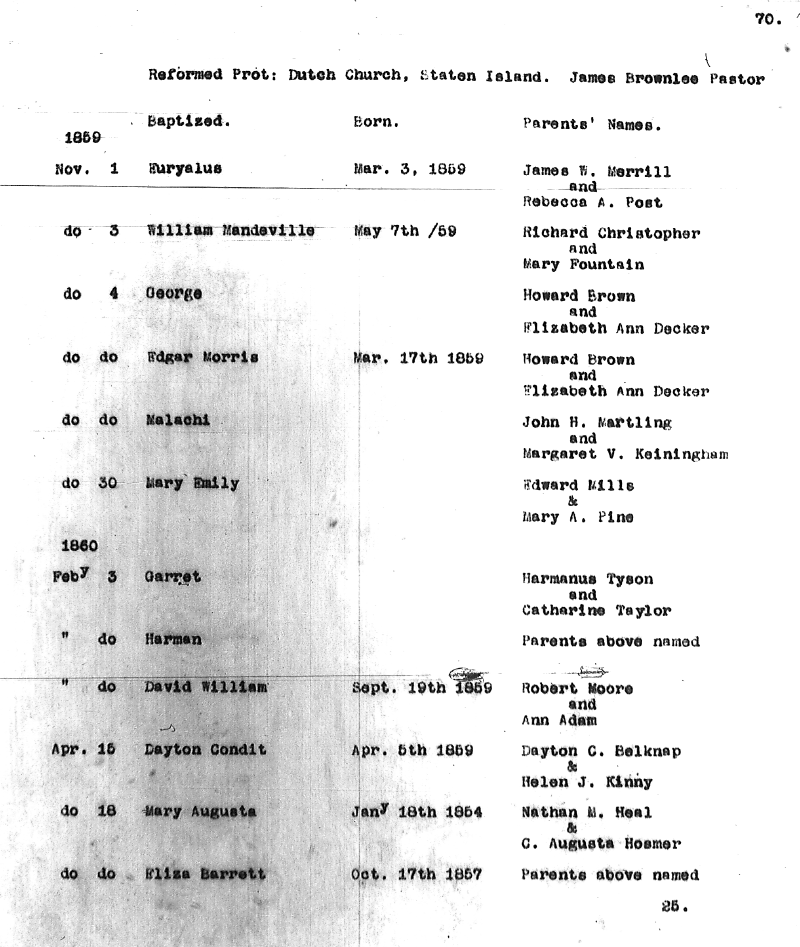
Date Baptized Parents’ Names Born 1859, Nov. 30 Mary Emily Edward Mills & Mary A. Pine
— Jan 1923, Records of the Reformed Protestant Dutch Church on Staten Island, New York City, v2, transcribed and edited by Royden Woodward Vosburgh, v2, p70, Staten Island, Richmond County, NY Genealogical Resources, FHL Film 514656 Item 5. Partial transcription.View largest available size.
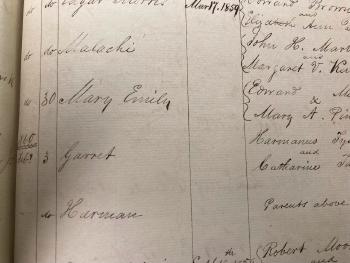
— Church Register 1790-1908, Reformed Dutch Church of Port Richmond, p25. Digitally photographed by Kathleen Langdon and used with permission via personal correspondence 05 Feb 2023. View largest available size.
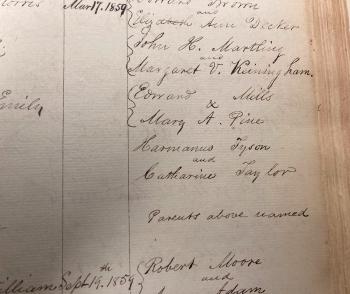
— Church Register 1790-1908, Reformed Dutch Church of Port Richmond, p25. Digitally photographed by Kathleen Langdon and used with permission via personal correspondence 05 Feb 2023. View largest available size.
Documentation suggests the Mills family moved from Staten Island to Corfu sometime between 01 Sept 1862 and 01 May 1863, a period overlapping Emily’s fourth birthday.
The family moved to Motts Corners in Mar 1879, which must have filled Emily with many mixed emotions. Corfu was her childhood home, where she had attended school, and she was leaving behind friends that she would make return trips to visit. But it was also where her brother Horace had killed himself just a few years prior.
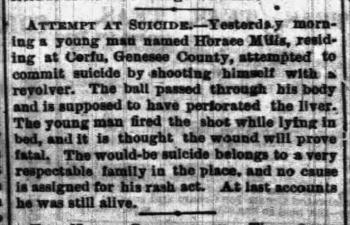
ATTEMPT AT SUICIDE.—Yesterday morning a young man named Horace Mills, residing at Corfu, Genesee County, attempted to commit suicide by shooting himself with a revolver. The ball passed through his body and is supposed to have perforated the liver. The young man fired the shot while lying in bed, and it is thought the wound will prove fatal. The would-be suicide belongs to a very respectable family in the place, and no cause is assigned for his rash act. At last accounts he was still alive.
— 17 Oct 1876, The Buffalo Commercial, Buffalo NY, p3, newspapers.com. View largest available size.
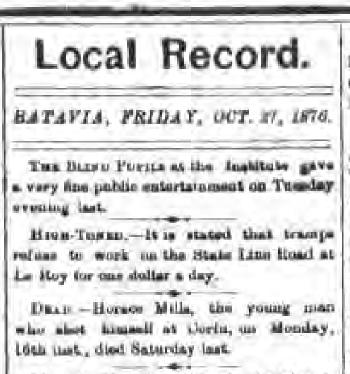
Local Record.
Batavia, Friday, Oct 27, 1876.
…
DEAD—Horace Mills, the young man who shot himself at Corfu, on Monday, 16th last, died Saturday last.
— 27 Oct 1876, The Progressive Batavian, Batavia NY, fultonhistory.com. View largest available size.
This was also a few months after Emily’s 20th birthday, and the move must have been an exciting one. Very soon after her arrival in Mott’s Corners, Emily was actively involved in several community social groups, providing clues to her personality as a young woman. Emily was energetic, outgoing and appeared to make friends easily, and it seems she was welcomed warmly by her new neighbors.
Emily joined the existing “High Bridge Lodge No. 296” of the Independent Order of Good Templars shortly after arriving in Mott’s Corners, as she “furnished entertainment for the good of the order” in August 1879. (20 Aug 1879, Ithaca Daily Journal, Ithaca NY, p4.) The Good Templars often met above Edward Mills’ store, “E. H. Mills”, in a space for public events and private meetings called Lounsbery Hall, named for the owner of the building, Edward Lounsbery. Emily was a member until at least August 1886, as attested by the meeting minutes of the Good Templars at that time, where she wrote the final three words recorded for High Bridge Lodge No. 296 on 27 Aug 1886: “Emily Mills Sec.”.
Emily held a number of offices in the Lodge over the years, and as a result of her time as Secretary, there are many more examples of her distinctive handwriting preserved.
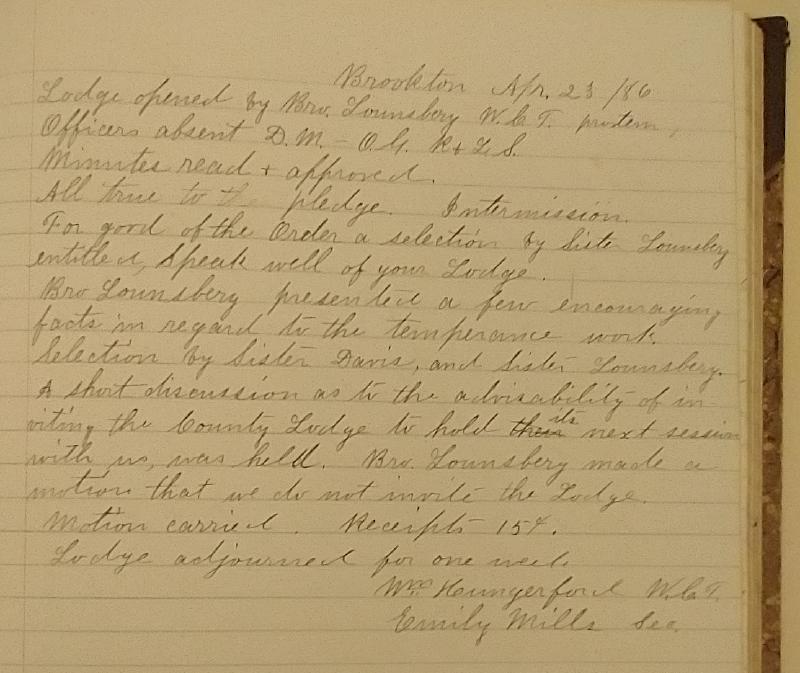
— 23 Apr 1886, Independent Order of Good Templars High Bridge Lodge No. 296, Tompkins County History Center, Ithaca NY. View largest available size.

— Quarterly Returns for Independent Order of Good Templars High Bridge Lodge No. 296, Tompkins County History Center. View largest available size.
The Good Templars’ meetings were both entertaining and educational by design, to offer a compelling alternative to drinking establishments, and Emily often contributed literary items to the “Good of the Order” portions of meetings in which members volunteered in advance to read or recite a short piece, such as a poem or essay. In the preserved meeting minutes of the lodge, the items for the Good of the Order were only identified in a minority of cases, but in the period from Apr 1883 to Aug 1886, Emily provided the following works that I have tried to identify:
| Dates | Recorded Citations | Possible Matches |
|---|---|---|
| 01 Jun 1883 | Misplaced Door Keys | 05 May 1883, “Door Keys”, Harper’s Bazar, p274. |
| 10 Aug 1883 | Something or Nothing | “Nothing and Something” by Frances Ellen Watkins Harper |
| 15 Feb 1884 | The Call of St. Gregory by John Greenleaf Whittier | “The Supper of St. Gregory” by John Greenleaf Whittier |
| 22 Feb 1884 | This Method | currently unknown |
| 25 Sep 1885 | One Day in a Country Store | may be “A Day in a Country Store” referenced elsewhere, but still unidentified |
| 01 Jan 1886 | L[?] customs in China | currently unknown |
| 29 Jan 1886 | Strive, Wait and Pray | “Strive, Wait, and Pray” by Adelaide A. Procter |
And on 15 Jan 1886: “Reading of a pleasant poem by Sis Mills”. There were many other times when Emily’s selections were not recorded, but simply noted as “selection by Sis. Mills” or similar. Years later, when Emily joined the Brookton chapter of the Women’s Christian Temperance Union, she held offices in the chapter just as she had in the Templar’s Lodge, including “Superintendent of Literature and Publications”.
Emily was also involved in the Caroline Amateur Dramatic Club, along with George Richardson and other Good Templars members. The Club, along with Dr. Besemer’s orchestra, gave several acclaimed performances of the play The Colleen Bawn, for the benefit of the Templars. Emily played supporting character “Sheelah”.
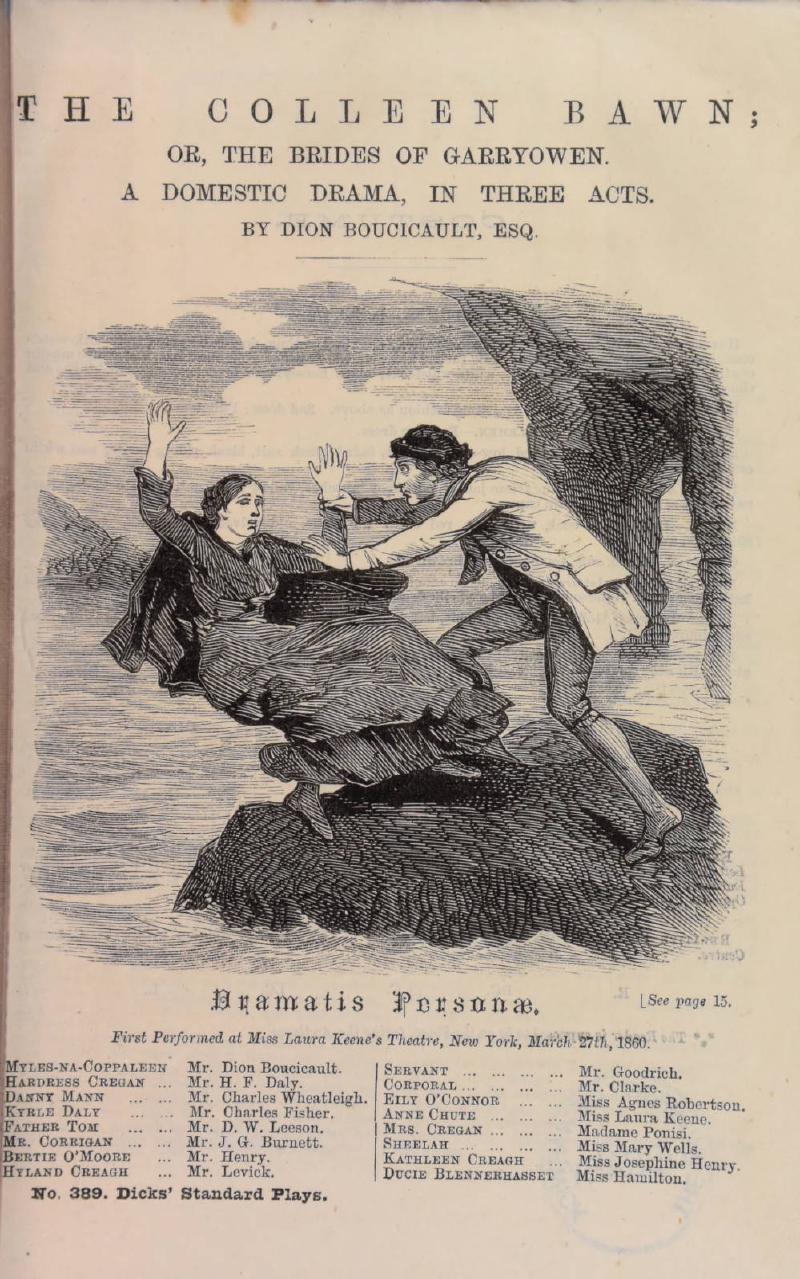
COLLEEN BAWN;
OR, THE BRIDES OF GARRYOWEN. DOMESTIC DRAMA, IN THREE ACTS.
BY DION BOUCICAULT, ESQ.
Dramatis Personae
First Performed at Miss Laura Keene’s Theatre, New York, March 27th. 1860.
Myles-na-Coppaleen … Mr. Dion Boucicault.
Hardress Cregan … Mr. H. F. Daly.
Danny Mann … Mr. Charles Wheatleigh.
Kyrle Daly … Mr. Charles Fisher.
Father Tom … Mr. D. W. Leeson.
Mr. Corrigan … Mr. J. G. Burnett.
Bertie O’Moore … Mr. Henry.
Hyland Creagh … Mr. Levick.
Servant … Mr. Goodrich.
Corporal … Mr. Clarke.
Eily O’Connor … Miss Agnes Robertson.
Anne Chute … Miss Laura Keene.
Mrs. Cregan … Madame Ponisi.
Sheelah … Miss Mary Wells.
Kathleen Creagh … Miss Josephine Henry.
Ducie Blennerhasset … Miss Hamilton.
No. 389. Dicks’ Standard Plays.
— The colleen bawn; or, the brides of Garryowen : a domestic drama, in three acts, Boucicault, Dion, 1820-1890, London : John Dicks, Identifier b13704126, Image Number colleenbawnorbri0000bouc_0003, Hall Collection of Prompt Books, Warwick Digital Collections. View largest available size.
The Colleen Bawn, or The Brides of Garryowen is a melodramatic play written by Irish playwright Dion Boucicault. It was first performed at Laura Keene’s Theatre, New York, on 27 March 1860 with Laura Keene playing Anne Chute and Boucicault playing Myles na Coppaleen. …The Colleen Bawn captivated audiences with its interwoven character plots and overall story.
— The Colleen Bawn, Wikipedia.org.

—The Caroline Amateur Dramatic Club will give an entertainment for the benefit of the High Bridge Lodge I. O. of G. T. at Lounsberry Hall, Mott’s Corners, Wednesday and Thursday evening January 14 and 15, 1880, consisting of the popular Irish drama, The Colleen Bawn, W. T. Graham, manager; Dr. Besemer, musical director; with the following cast: Miles na Copleen, J. T. Merrill; Hardress Cregan, C. A. Denman; Danny Mann, W. T. Graham; Kyle Dailey, Rube Merrill; Corrigan, D. F. Vannetten; Father Tom, Will Montgomery; Bertie O’Moore, Geo. H. Richardson; Patsey O’Moore, Frank King; Servant, Geo. Seager; Eily O’Conner, (The Colleen Bawn); Miss Eloria Landon; Anna Chute, Mrs. Adda I. Merrill; Mrs. Cregan, Mrs. Dr. Besemer; Sheelah, Miss Emily Mills; Kathleen, Miss Gussie Merrill; Ducie, Miss Cynthia, Vorhis.
J. S. W.
— 07 Jan 1880, Ithaca Daily Journal, Ithaca NY, p4, nyshistoricnewspapers.org. View largest available size.
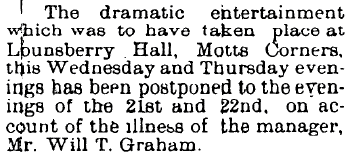
The dramatic entertainment which was to have taken place at Lounsberry Hall, Motts Corners, this Wednesday and Thursday evenings has been postponed to the evenings of the 21st and 22nd, on account of the illness of the manager, Mr. Will T. Graham.
— 14 Jan 1880, Ithaca Daily Journal, Ithaca NY, p4, nyshistoricnewspapers.org. View largest available size.
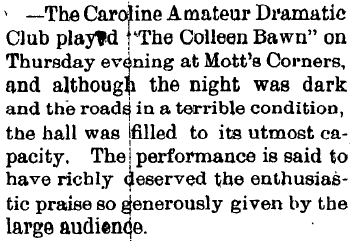
—The Caroline Amateur Dramatic Club played “The Colleen Bawn” on Thursday evening at Mott’s Corners, and although the night was dark and the road in a terrible condition, the hall was filled to its utmost capacity. The performance is said to have richly deserved the enthusiastic praise so generously given by the large audience.
— 24 Jan 1880, Ithaca Daily Journal, Ithaca NY, p4, nyshistoricnewspapers.org. View largest available size.

MOTT’s Corners.
The amusement loving public will have another opportunity of witnessing the play of Colleen Bawn, on Wednesday and Thursday evenings, Feb. 4th and 5th. The Caroline Amateur Dramatic Club has met with public favor. It certainly deserves it. Its members have been studying assiduously, and must have improved greatly. We shall expect to see some of the parts played with a good deal of feeling and power. Some of the situations afford an abundant opportunity for the display of emotional talents.
—We have the gratifying assurance that an immediate effort, will be made to secure a pastor at the Congregational Church.
—The report that Capt. Personius would pass the summer in Europe is incorrect.
—Geo. Depuy who has held the highly responsible position of telegraph operator (U., L & E. R. R) is soon to be promoted, and will leave us for a more profitable position.
—One or two new residences will soon be ready for occupancy.
—Mr. “Al” Merritt has sold his horse (Mountain Boy) so much admired, for $800. He will be sent to California for a much larger sum.
—There will a complimentary meeting of Rev. Mr. Brown’s friends this week. His faithful service to the public 1s entitled to the highest reward. Those who find it inconvenient to attend should remember that he can be reached in other generous ways. G.
— 28 Jan 1880, Ithaca Daily Journal, Ithaca NY, p4, nyshistoricnewspapers.org. View largest available size.

–The Caroline Amateur Dramatic Club repeated the drama “The Colleen Bawn” here on Wednesday and Thursday evenings of last week. They were greeted with a crowded house on both evenings and universal praise was bestowed upon all the members of the club. Where the characters were all so well sustained it would be difficult to make particular mention of any without doing injustice to others. Competent critics pronounce it to be much superior to amateur performances in general. The music was furnished by Dr. Besemer’s orchestra and was fully in keeping with the performance on the stage. The club have received pressing invitations to present the play at Candor, Danby, Slaterville and several other places.
— 11 Feb 1880, Ithaca Daily Journal, Ithaca NY, p4, nyshistoricnewspapers.org. View largest available size.
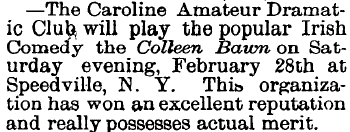
—The Caroline Amateur Dramatic Club will play the popular Irish Comedy the Colleen Bawn on Saturday evening, February 28th at Speedville, N. Y. This organization has won an excellent reputation and really possesses actual merit.
— 18 Feb 1880, Ithaca Daily Journal, Ithaca NY, p4, nyshistoricnewspapers.org. View largest available size.

—The Mottville Dramatic Association will favor Danby people with their popular play “Colleen Bawn” on Wednesday evening next.
— 26 Feb 1880, Ithaca Daily Journal, Ithaca NY, p4, nyshistoricnewspapers.org. View largest available size.
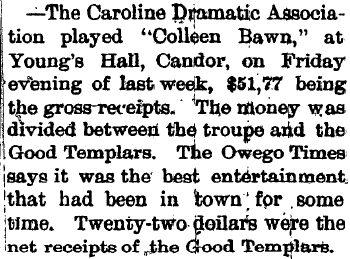
The Caroline Dramatic Association played “Colleen Bawn,” at Young’s Hall, Candor, on Friday evening of last week, $51,77 being the gross receipts. The Money was divided between the troupe and the Good Templars. The Owego Times says it was the best entertainment, that had been in town for some time. Twenty-two dollars were the net receipts of the Good Templars.
— 05 Mar 1880, Ithaca Daily Journal, Ithaca NY, p4, nyshistoricnewspapers.org. View largest available size.
Although not a large role, Sheelah is in key scenes and her character gave Emily an opportunity to deliver substantial dialogue, perform powerful emotions and even be involved in physical action. Here are some of the words spoken by Emily on those evenings in Jan and Feb 1880, in Lounsbery Hall at Mott’s Corners, above her father Edward’s store where she clerked:
Sheelah The poor Colleen! Oh, no, Danny, I knew she’d die of the love that was chokin’ her. He didn’t know how tindher she was when he gave her the hard word. What was that message the masther sent to her, that he wouldn’t let me hear? It was cruel, Danny, for it broke her heart entirely; she went away that night, and, two days after, a cloak was found floatin’ in the reeds, under Brikeen Bridge; nobody knew it but me. I turned away, and never said—. The creature is drowned, Danny, and woe to them as dhruv her to it. She has no father, no mother to put a curse on him, but the Father above that niver spakes till the last day, and then
—[She turns and sees Danny gasping, his eyes fixed on her, supporting himself on his arm.]
Danny! Danny! he’s dyin’—he’s dyin’!
[Runs to him, R. of bed.]
— The Colleen Bawn by Dion Boucicault Act III, Scene I.
[Enter Sheelah, guarded by two Soldiers, R.]
Sheelah [Crying.] What’s this? Why am I thrated this way—what have I done?
Corrig You are wanted a while—it’s your testimony we require. Bring her this way. Follow me! [Exit, L.]
Sheelah [Struggling.] Let me go back to my boy. Ah! good luck t’ye, don’t kape me from my poor boy! [Struggling.] Oh! you dirty blackguards, let me go—let me go!
[Exit Sheelah and Soldiers, L.]
— The Colleen Bawn by Dion Boucicault Act III, Scene IV.
The Good Templars may have also provided opportunities for Emily to travel, as the Good Templars commonly attended events at other Lodges in Tompkins County, cooperated with other temperance groups, and they sent representatives to the state “Grand Lodge” as well. Because of this, Emily may be present in some of the well known photographs of other temperance groups in Caroline.
When Lodge No. 296 disbanded after Aug 1886, just over seven years after Emily joined, she must have keenly felt its absence in her life. From the information I have seen so far, I cannot say if she joined High Bridge Lodge again when it re-formed a few years later with the number 720. Emily eventually joined the WCTU, but I don’t know when. It is interesting to note however, that the Brookton chapter of the WCTU organized in 1907, the same year the Emily was baptized by the Reverend Annis Ford Eastman.
More information on Emily’s activities in High Bridge Lodge–including more discussion of the items she furnished for the “Good of the Order”–and the WCTU, can be found in the following pages:
Emily is mentioned in the will of her uncle, Henry Higbie:
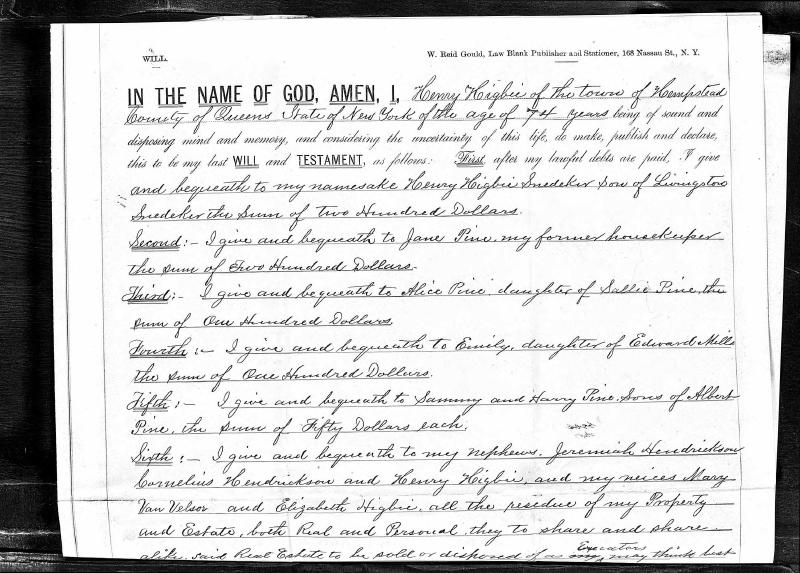
Fourth: I give and bequeath to Emily, daughter of Edward Mills, the sum of One Hundred Dollars.
— 21 Oct 1881, Last Will and Testament of Henry Higbie of Hempstead Long Island, ancestry.com. Partial transcription.View largest available size.
Emily returned to Corfu in later years to bury Jonas, Mary Ann and Edward. She also returned to Corfu to visit her childhood friends.

Miss Emily Mills, is visiting friends in town.
— 21 Jul 1882, The Batavia Daily News, Batavia NY, p1, nyshistoricnewspapers.org. View largest available size.
At least by the 1890’s, Emily was working as a clerk in her father’s store, just as her older brothers had. (She may have always helped with the store, or perhaps she only began clerking in the store after Jonas died.) Several volumes of sales journals have survived from M. E. Mills general store that are written by Emily’s hand (and certainly Ellen Gould’s handwriting must also be present in those books).
Many aspects of Emily’s handwriting are quite distinctive—such as uppercase E’s, M’s, W’s, C’s, T’s and F’s as well as lowercase p’s are often written with similar idiosyncrasies. Note for example, the following page of entries in M. E. Mills sales journals, which appears to be entirely written by Emily.
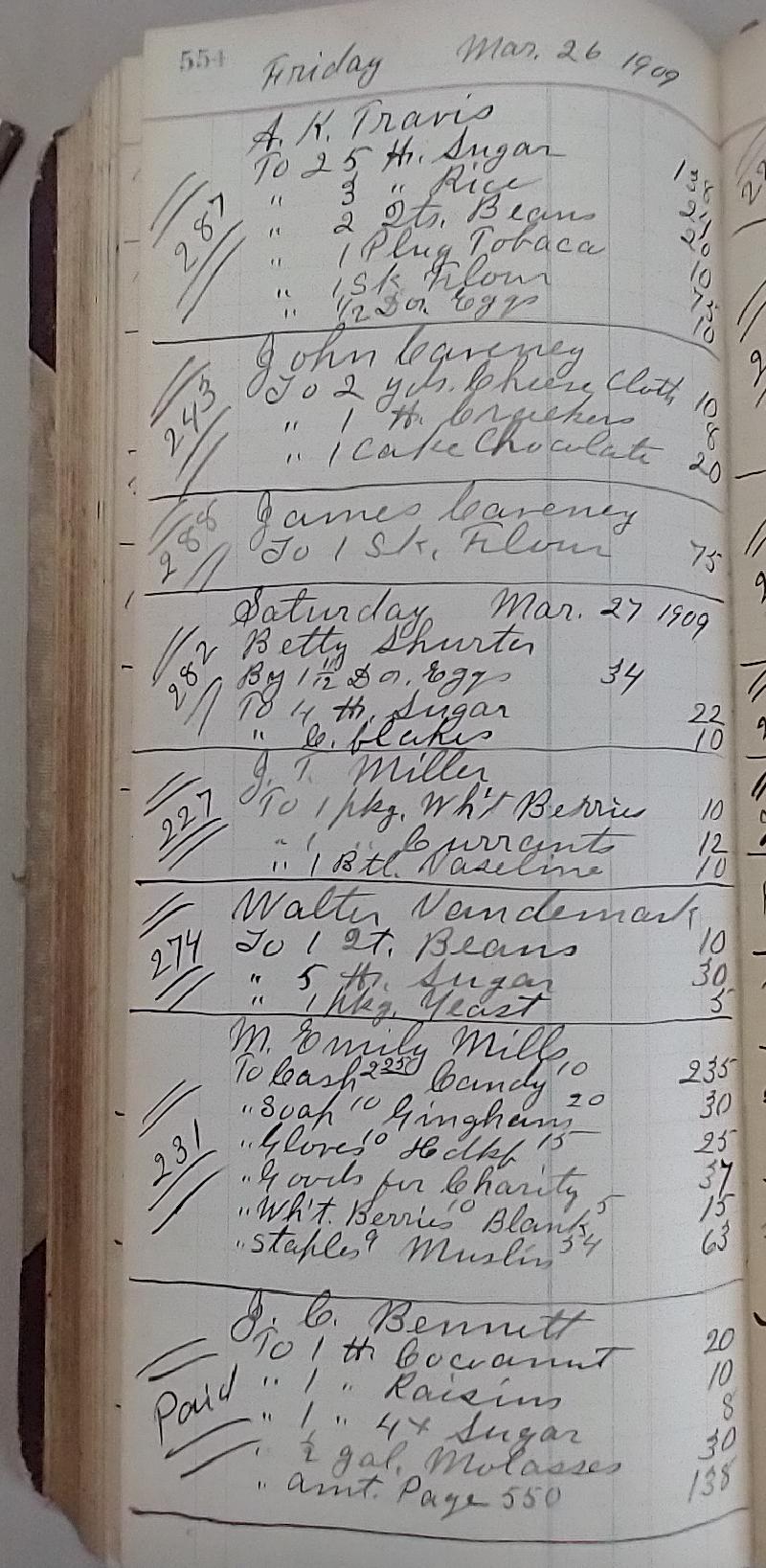
— 26 Mar 1909, E. H. Mills Store Sales Journal No. 41, p554 digital photograph of book owned by Brooktondale collector. View largest available size.
Her E’s C’s L’s and J’s tend to have big loops. Her lowercase p’s practically pierce the line above it. And her uppercase T’s and F’s have distinctive crosses that rise and fall. Her handwriting is easily recognizable, and when others (most likely Ellen Gould) make entries in the Mills’ store journals, the differences are apparent.
Interestingly, her T’s are sometimes written quite differently. See for example, the way “to” is written in the entries for John and James Caveny vs. those for J. T. Miller and Emily herself. These very different looking T’s appear to all be written by Emily given other matches that can be verified, including most obviously, the capital J’s which all begin in the center with an extra initial loop.
Jonas died on 14 October 1885 after a brief illness. Whether Emily worked in the store prior to Jonas’ death, by 1892, she lists herself as clerk in the state census.
A small glimpse of Emily’s interests around that time:
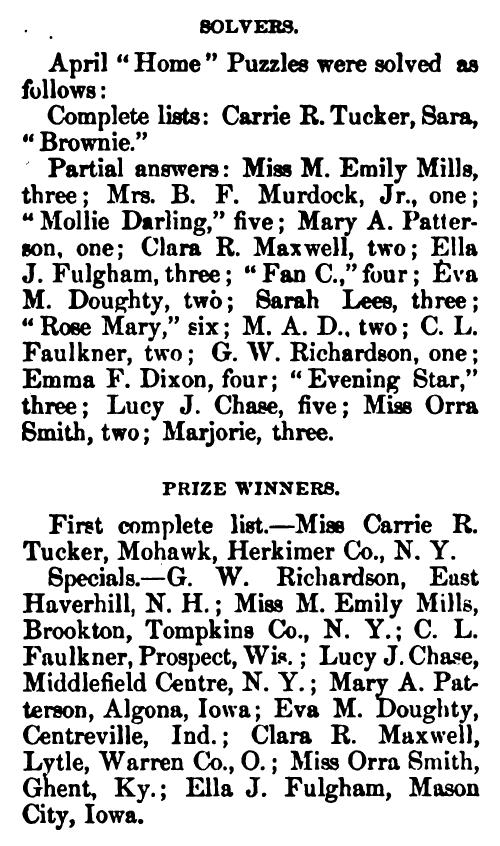
SOLVERS.
April …
Partial answers: Miss M. Emily Mills, three; …
PRIZE WINNERS.
… Miss M. Emily Mills, Brookton, Tompkins Co., N. Y.; …
— 1887, Arthur’s Home Magazine, v56, p106, books.google.com. View largest available size.
Emily acted as nurse at the end of her mother’s life:

DEATH OF MRS. E. H. MILLS.
Event occurred in Brookton, Tompkins County—Interment at Corfu.
Corfu, Dec 31.—The remains of Mrs. E. H. Mills of Brookton, Tompkins county, arrived here on the 4:26 p. m. train yesterday and were interred in Evergreen Hill Cemetery. The deceased was the wife of Edward H. Mills who was for many years a prominent merchant in this village who removed to Tompkins county sixteen years ago, re-engaging in mercantile pursuits, and where he has since resided.
Mrs. Mills was in usual health a week ago yesterday morning, but before night complained of a soreness in one of her fingers. Her daughter examined it and found what appeared to be a small splinter of wood, which she removed and which appeared to relieve her, but blood poisoning ensued and she continued to grow worse until Saturday, when death relieved her of her suffering. Her remains were accompanied by her husband and an only daughter, Emily Mills, who alone survive her and who possess the heartfelt sympathy of many friends in this vicinity who remember her as a kind friend and a devoted Christian whose sublime faith made her life beautiful and to the last degree exemplary.
Mr. Mills and daughter spent last night with Mr. and Mrs. W. W. McGregor and returned home this morning.
— 31 Dec 1895, The Daily News, Batavia NY, p1, nyshistoricnewspapers.org. View largest available size.
In 1907, Emily was baptized and officially joined the membership roll of Brookton Congregational Church, along with 10 other single women, in a ceremony officiated by Reverend Annis Ford Eastman. A closer examination of the circumstances around the baptism can be found here. It is unclear what Emily’s religious outlook was before being baptized, but at least from that point on, Emily’s faith was a very important part of her life.
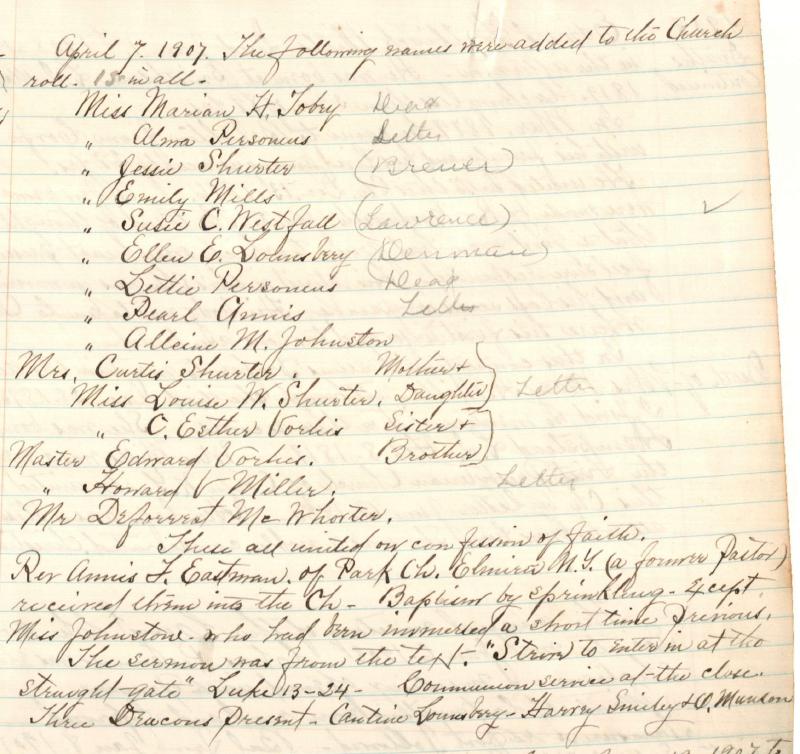
April 7, 1907. The following names were added to this Church roll, 15 in all.
Miss Marian H. Toby Dead
" Alma Personius Letter
" Jessie Shurter (Brewer)
" Emily Mills
" Susie C. Westfall (Lawrence)
" Ellen E. Lounsbery (Denman)
" Lettie Personius Dead
" Pearl Annis letter
" Alleine M. Johnston
Mrs. Curtis Shurter, Mother &
Miss Louise W. Shurter, Daughter letter
" C. Esther Vorhis Sister &
Mister Edward Vorhis, Brother
" Howard V. Miller Letter
Mr. Deforrest McWhorter
These all united on confession of faith.
Rev. Annis F. Eastman of Park Ch. Elmira N.Y. (a former Pastor) received them into the Ch. Baptism by sprinkling, except Miss Johnston who had been immersed a short time previous.
The sermon was from the text “Strive to enter in at the straight-gate” Luke 13-24. Communion service at the close. Three Deacons present, Cantine Lounsbery, Harvey Smiley & O. Munson
— Digitally scanned entry in Congregational Church 1868-1933 Minutes of Meetings and Membership, used with permission from Caroline Valley Community Church. View largest available size.
This photo, taken on 13 Jun 1907 shows the Congregational Church as Emily knew it then, with the original steeple:
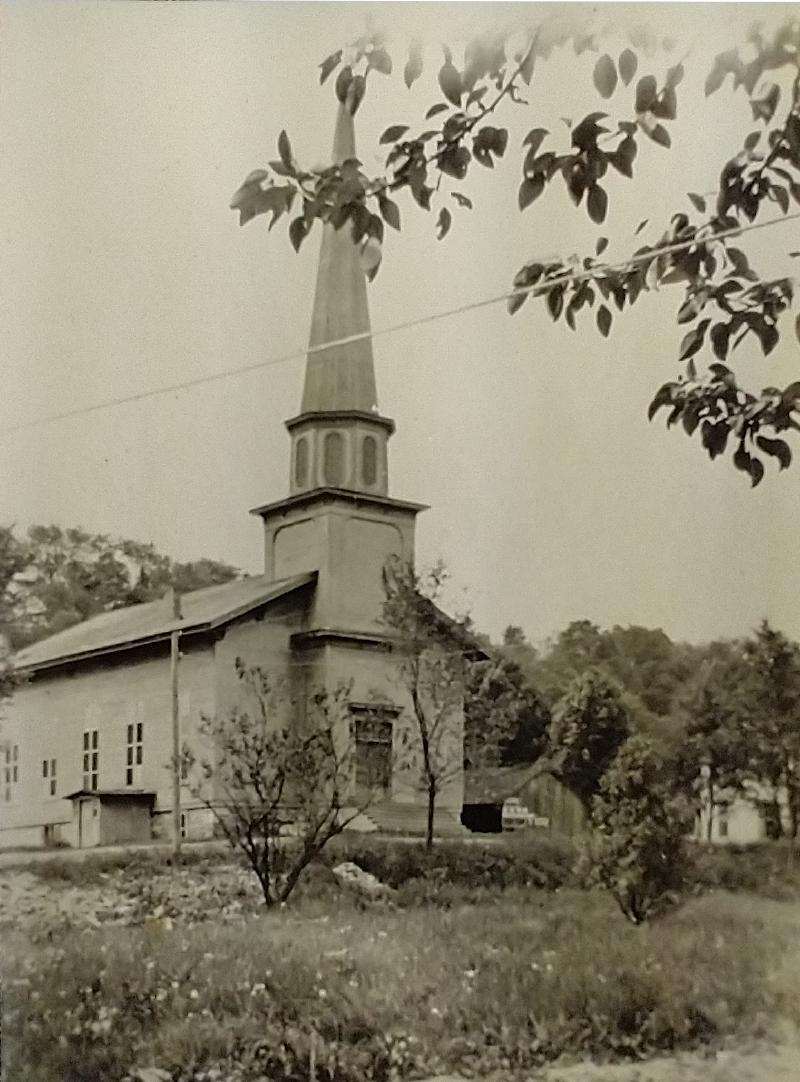
— 13 Jun 1907. Digital photograph of print photograph, used with permission from Caroline Valley Community Church. View largest available size.
Emily, along with many of the others baptized with her, immediately became deeply involved in church activities, a level of commitment they sustained the rest of their lives. Emily was a Sunday School teacher, and possibly taught classes specifically for adults. There are newspaper accounts detailed below of her organizing bible study groups and prayer meetings in her home. In the following report, dated the eve of Edward’s death, we see that in the months immediately after joining the church, Emily taught a class with an average attendance of five students:
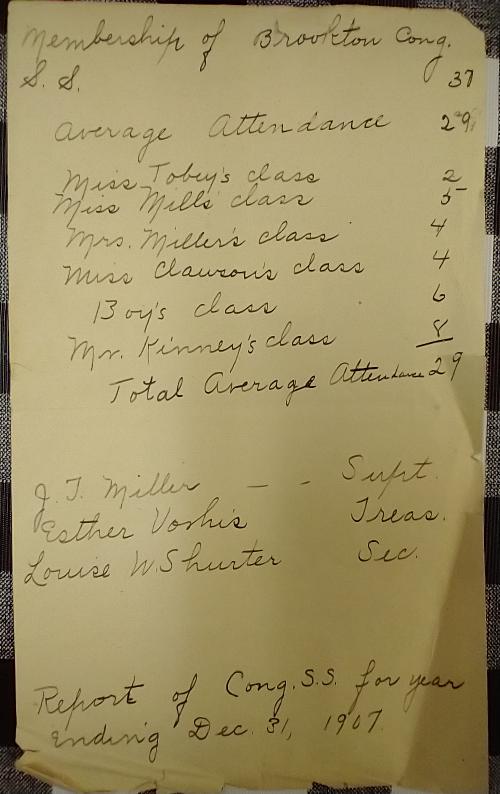
— 31 Dec 1907. Digitally photographed record from Caroline Valley Community Church, used with permission. View largest available size.
Gertrude Conant (19 Jul 1924 to 04 Sep 2007) mentions that Emily played the piano or organ in the Church. The church historical records, as one would naturally expect, cover topics unevenly over the years. Concerning the piano/organ: there was an organ in the church at one time, but it was destroyed by mice. The roles of pianist/organist and that of assistant pianist/organist, were for a time at least, positions that were voted on at the annual meetings just as officers such as secretary and treasurer were. I have not found any references for Emily being in either of those roles, but there are many years where these roles are not noted at all, so unless Gertrude is mis-remembering, without her noting this detail, it would be lost. (Anna Mulks and Cassie Landon were several times noted in these roles.) I will also point out, however, that in the many newspaper accounts and meeting minutes of the Good Templars, there are many mentions of Emily providing literary items for the “Good of the Order”, but I don’t see any mentions of her providing musical entertainment, which was also a weekly occurrence at their meetings. The Good Templars Lodge, which met above Mills’ Store, was known to have an organ.
Originally a pipe organ stood on a raised platform (for choir) at the back of the auditorium. After it deteriorated (with assistance from the church mice) a piano was used. During the pastorate of Rev. James L. Burckes (1949-1955) the platform was eliminated and double entrance doors cut in the curving wall. Prior to that time there had been only a single entrance door at each side of the wall.
Annual meetings were typically held the first Monday in January, in the afternoon or evening. A small group attended and Emily is not listed as attending these meetings, despite being elected as Treasurer and being acknowledged as filling that role for at least two years:

Miss Emily Mills, Tres.
— 16 Jan 1913, Annual Meeting of Brookton Congregational Church. Sunday School Report for 1912. Digitally photographed entry in Congregational Church 1868-1933 Minutes of Meetings and Membership, used with permission from Caroline Valley Community Church. View largest available size.

Tres. report - Miss Mills Tres.
— 05 Jan 1914, Annual Meeting of Brookton Congregational Church. Digitally photographed entry in Congregational Church 1868-1933 Minutes of Meetings and Membership, used with permission from Caroline Valley Community Church. View largest available size.

Miss Emily Mills
Mrs. Hannah Mills
— Digitally photographed entry in Congregational Church 1868-1933 Minutes of Meetings and Membership, used with permission from Caroline Valley Community Church. View largest available size.

— Digitally photographed entry in Congregational Church 1868-1933 Minutes of Meetings and Membership, used with permission from Caroline Valley Community Church. View largest available size.

— Digitally photographed entry in Congregational Church 1868-1933 Minutes of Meetings and Membership, used with permission from Caroline Valley Community Church. View largest available size.

Dec 18, 1921
At a special meeting called after the morning services, Miss Ella Richards elected chairman. Motion made and seconded to ask for the missionary aid (Motion made by Mr. Wallace seconded by Mr. Richard.) Motion that the chairman appoint the committee of three carried, and Mr. Skinner, Miss Mills & Mrs. Trap appointed.
— 18 Dec 1921, Digitally photographed entry in Congregational Church 1868-1933 Minutes of Meetings and Membership, used with permission from Caroline Valley Community Church. View largest available size.
Emily continued to be involved in temperance into the 1900’s, and for some period of time, she was a member of the Women’s Christian Temperance Union, along with her step-mother Hannah. This is almost certainly unknowable now, but I have wondered if Hannah was introduced to Edward through the Emily’s involvement with temperance. This may also be how Emily knew Ellen Gould. It is interesting to note that the Brookton chapter of the W.C.T.U. was organized in 1907—the year of Emily Mills’ and Jessie (Shurter) Brewer’s baptism—and that Jessie is also active in the W.C.T.U.
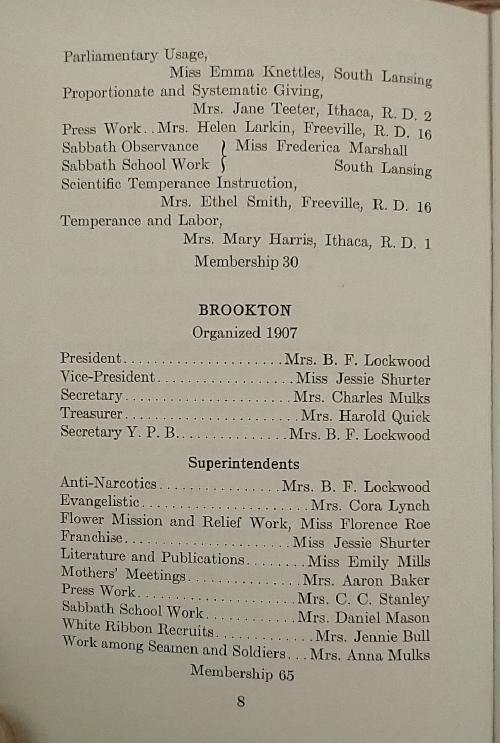
… BROOKTON
Organized 1907
President… Mrs. B. F. Lockwood
Vice-President… Miss Jessie Shurter
Secretary… Mrs. Charles Mulks
Treasurer… Mrs. Harold Quick
Secretary Y.P.B…. Mrs. B. F. Lockwood
Superintendents
Anti-Narcotics… Mrs. B. F. Lockwood
Evangelistic… Mrs. Cora Lynch
Flower Mission and Relief Work, Miss Florence Roe
Franchise… Miss Jessie Shurter
Literature and Publications… Miss Emily Mills
Mothers’ Meetings… Mrs. Aaron Baker
Press Work… Mrs. C. C. Stanley
Sabbath School Work… Mrs. Daniel Mason
White Ribbon Recruits… Mrs. Jennie Bull
Work among Seamen and Soldiers… Mrs. Anna Mulks
Membership 65
— Directory 1917-1918, Women’s Christian Temperance Union, Tompkins County, New York, p8. Tompkins County History Center, Ithaca NY. View largest available size.
Edward died on New Year’s day 1908, and Emily made another heartbreaking trip to Evergreen Hill Cemetery in Corfu. If Emily walked the streets of Corfu on that trip, she should would have seen that the building that housed her family’s store, as well as her childhood home, were now gone.

EDWARD H. MILLS.
Edward H. Mills died on January 1 at the advanced age of 88 years. Mr. Mills was a merchant in Brookton for the past twenty-nine years, and was postmaster during the Cleveland administration. He is survived by his wife and one daughter. The funeral was held on January 2 and the burial took place Friday last in Corfu.
— 06 Jan 1908, Ithaca Daily Journal, Ithaca NY, p3, nyshistoricnewspapers.org. View largest available size.

Former Corfu Merchant Dead.
Corfu, Jan. 6. —The body of E. H. Mills, who conducted a general store in Corfu over 25 years ago, was brought on Friday evening from Ithaca and buried in Evergreen Hill cemetery. The Rev. W. W. Robinson conducting the services. The body was accompanied by Mr. Mills daughter, Miss Emily Mills. Mr. Mills was 89 years old.
— 06 Jan 1908, The Daily News, Batavia NY, p4, nyshistoricnewspapers.org. View largest available size.
Edward died “intestate”, without a will, and it wasn’t until July 1909 that Emily and Hannah, working with their lawyer Fordyce Cobb, became official legal co-owners of the Mills’ home and Mills’ store assets. Emily followed her father’s example and renamed the store M. E. Mills. When Hannah passed less than a decade later, Emily inherited all assets and property.

M. Emily Mills was made administrator of the estate of Edward H. Mills, who died in Caroline on January 1. The estate amounts to $5,000 in personal property and $800 in realty.
— 07 Apr 1908, Ithaca Daily Journal, Ithaca NY, p3, nyshistoricnewspapers.org. View largest available size.

— 07 Apr 1908, Admin Minutes, Orders, Decrees, Vol 056, p416, Surrogate Court, Tompkins County, Ithaca NY, ancestry.com. View largest available size.

The final accounting in the estate of Edward H. Mills, who died in the Town of Caroline, was rendered by Tompkins, Cobb & Cobb. The estate is valued at $4,000.
— 02 Aug 1909, Ithaca Daily News, Ithaca NY, p5, fultonhistory.com. View largest available size.

— 02 Aug 1909, Minutes, Orders, Decrees, Vol 55a, p159, Surrogate Court, Tompkins County, Ithaca NY, ancestry.com. View largest available size.
Thanks to Gertrude Conant’s personal recollections, we have a basic description of Emily’s appearance and personality:
Emily Mills was a little woman, with her hair in a bun on top of her head, like Grandma Bacon’s. She was quiet, neat, cheerful and always smiling.
...I remember her as very kind...
- Full quote and citation are below. Ralph Conant in personal correspondence 24 Jul 2021 identifies “Grandma Bacon” as Mary Louise (Vandemark) Bacon (1867-1950).
She was a "sweet little lady"
And from E. D. Shurter’s Tribute:
Reserved, unostentatious, and kindly...she went about her daily round of duties with a Christian fortitude and faithfulness...
These descriptions of Emily’s demeanor are consistent with the personal recollections of a current Brooktondale resident, currently in her 90’s who has early childhood memories of Emily and her store in the last years of Emily’s life.
Due to the level of detail given to the context of this story, I am choosing to include the entire text and not just Emily’s section:

… Brookton, January 13.
…The following officers were elected by the Congregational Sunday School for the year. Superintendent, Jerome T. Miller; assistant superintendent, Miss Emily Mills; secretary, Russell Phillips; treasurer, Mrs. Cassie Landon.
— 15 Jan 1909, Ithaca Daily Journal, Ithaca NY, p7, nyshistoricnewspapers.org. View largest available size.

Miss Esther Vohis and Miss Emily Mills were in Ithaca Wednesday.
— 06 Dec 1913, Ithaca Daily Journal, Ithaca NY, p11, nyshistoricnewspapers.org. View largest available size.
Hannah died 25 Feb 1917, and the funeral was held the following Wednesday in the Mills’ home.

Mrs. Gould is keeping house for Miss Emily Mills.
— 20 Mar 1917, The Ithaca Journal, Ithaca NY, p7, newspapers.com. View largest available size.
Emily, along with Edward and Hannah, are mentioned in the diaries of George Jansen.
From 1908 to 1925 an itinerant worker named George Jansen, who dug gardens, painted rooms or houses, washed dishes, or “kept house” when an owner went on a trip, recorded events in Brookton along with the daily weather.
— 1998, Molly Adams, “Town of Caroline” in The Towns of Tompkins County: From Podunk to the Magnetic Springs edited by Jane Marsh Dieckmann, p62.

George E Jasen’s diaries
small note books, red and brown
in which he noted each day the weather,
temperature, and comments on daily life,
and people he knew, where and what he worked
at and any unusual events
— Gertrude Conant Collection, Caroline History Room, Slaterville Springs NY. View largest available size.
George notes in a number of entries throughout the years that he did odd jobs for Emily, such as painting her home and the store as well as planting her garden.
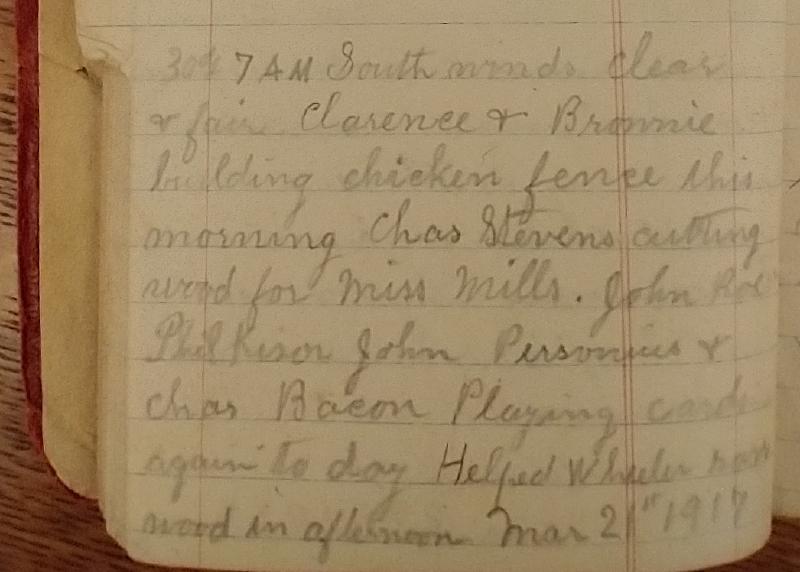
30 dg 7AM South winds clear & fair. Clarence & Brownie building chicken fence this morning Chas Stevens cutting wood for Miss Mills. John Roe Phil Kiso[r] John Personius & Chas Bacon Playing cards again today Helped Wheeler saw wood in afternoon.
Mar 21st 1917
— Notebooks of George E. Jansen, Tompkins County History Center, Ithaca NY. View largest available size.
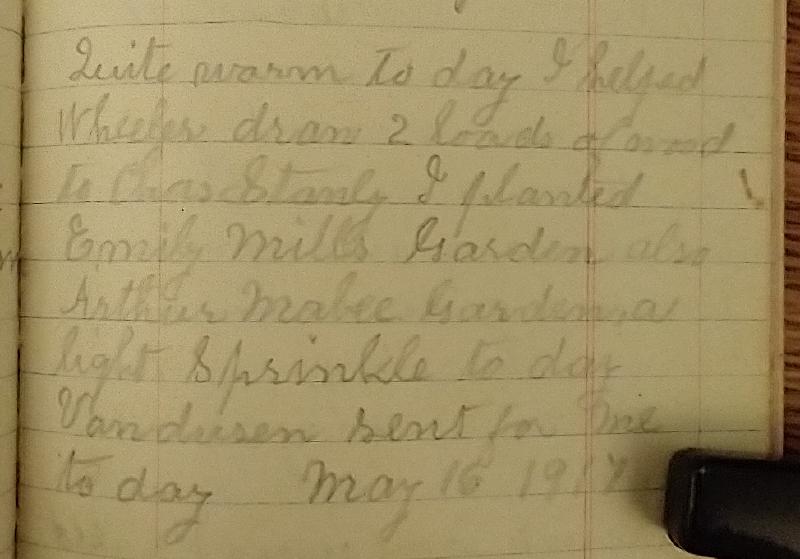
Quite warm to day I helped Wheeler draw 2 loads of wood to Chas Stanly I planted Emily Mills garden also Arthur Mabee garden, a light sprinkle to day Vandusen sent for me to day
May 16 1917
— Notebooks of George E. Jansen, Tompkins County History Center, Ithaca NY. View largest available size.
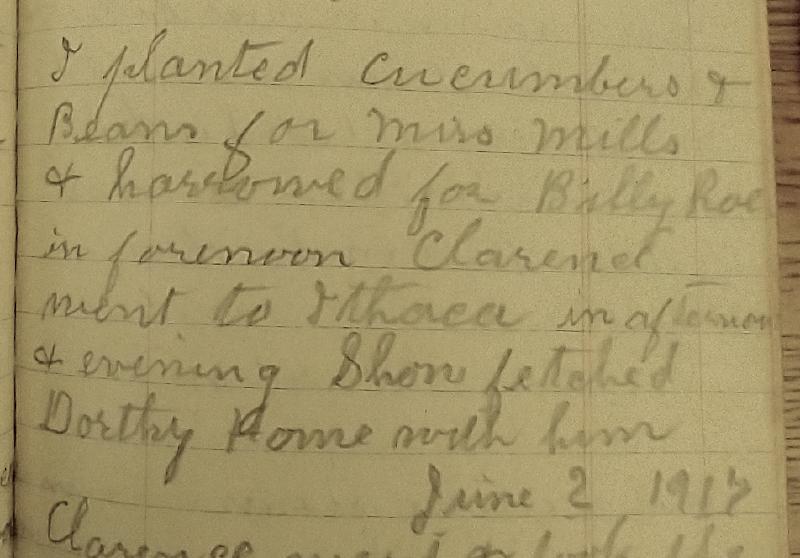
I planted cucumbers & beans for Miss Mills & harrowed for Billy Roe in forenoon Clarence went to Ithaca in afternoon & evening Shon[?] fetched Dorthy home with him
June 2 1917
— Notebooks of George E. Jansen, Tompkins County History Center, Ithaca NY. View largest available size.
It seems likely that Emily grew a garden not just for her own use, but to have fresh vegetables to sell in her store:
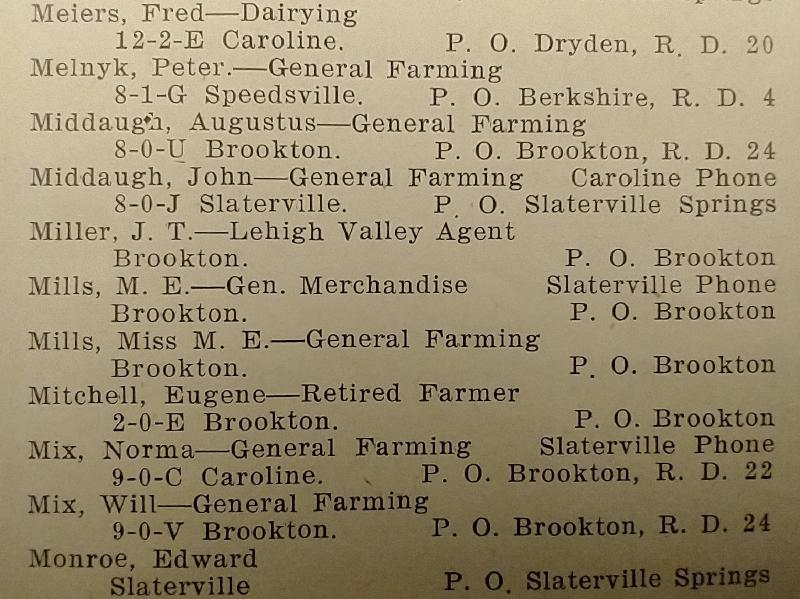
… Mills, M. E.—Gen. Merchandise Slaterville Phone
Brookton. P. O. Brookton
Mills, Miss M. E.—General Farming
Brookton. P. O. Brookton …
— 1920, “Clock System” Map and Farmer Directory, Tompkins County History Center, Ithaca NY. View largest available size.
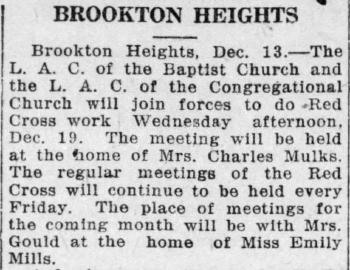
Brookton Heights
Brookton Heights, Dec. 13.—The L. A. C. of the Baptist Church and the L. A. C. of the Congregational Church will join forces to do Red Cross work Wednesday afternoon, Dec. 19. The meeting will be held at the home of Mrs. Charles Mulks. The regular meetings of the Red Cross will continue to be held every Friday. The place of meetings for the coming month will be with Mrs. Gould at the home of Miss Emily Mills.
— 13 Dec 1917, The Ithaca Journal, Ithaca NY, p7, newspapers.com. View largest available size.
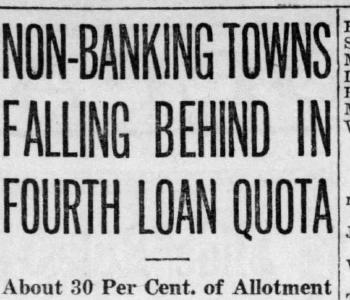
NON-BANKING TOWNS FALLING BEHIND IN FOURTH LOAN QUOTA
… $100—Edna Middah, Jerome T. Miller, Emily Mills, Benjamin Northrup, Mary E. Nuttall, Thomas Nuttall, Howard J. Phillips, Lewis B. Roe, Emily N. Smith, Robert L. Speed. …
(Partial transcription, emphasis added. Click on full size image to view complete text of article.)
— 15 Oct 1918, The Ithaca Journal, Ithaca NY, p9, newspapers.com. View largest available size.

Mrs. Gould and Miss Emily Mills enjoyed a radio concert at the home of Mr. and Mrs. Charles Mulks Wedesday evening.
— 24 Apr 1923, The Ithaca Journal, Ithaca NY, p9, newspapers.com. View largest available size.

A large number of friends of Mr. and Mrs. Charles Mulks are enjoying church services and concerts by radio. Mr. and Mrs. Mulks purchased a set some time ago.
— 11 Apr 1923, The Ithaca Journal, Ithaca NY, p11, newspapers.com. View largest available size.
George Jansen painted Emily’s home in the Summer of 1924:
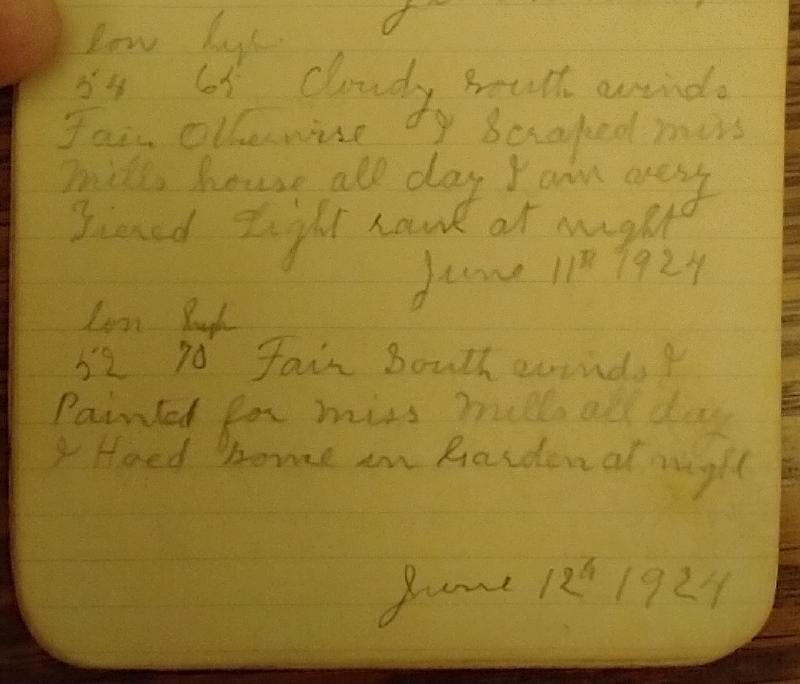
low 54 high 65 Cloudy south winds Fair otherwise I scraped Miss Mills house all day I am very tiered Light rain at night
June 11th 1924
low 52 high 70 Fair south winds I painted for Miss Mills all day & hoed some in garden at night
June 12th 1924
— Notebooks of George E. Jansen, Tompkins County History Center, Ithaca NY. View largest available size.
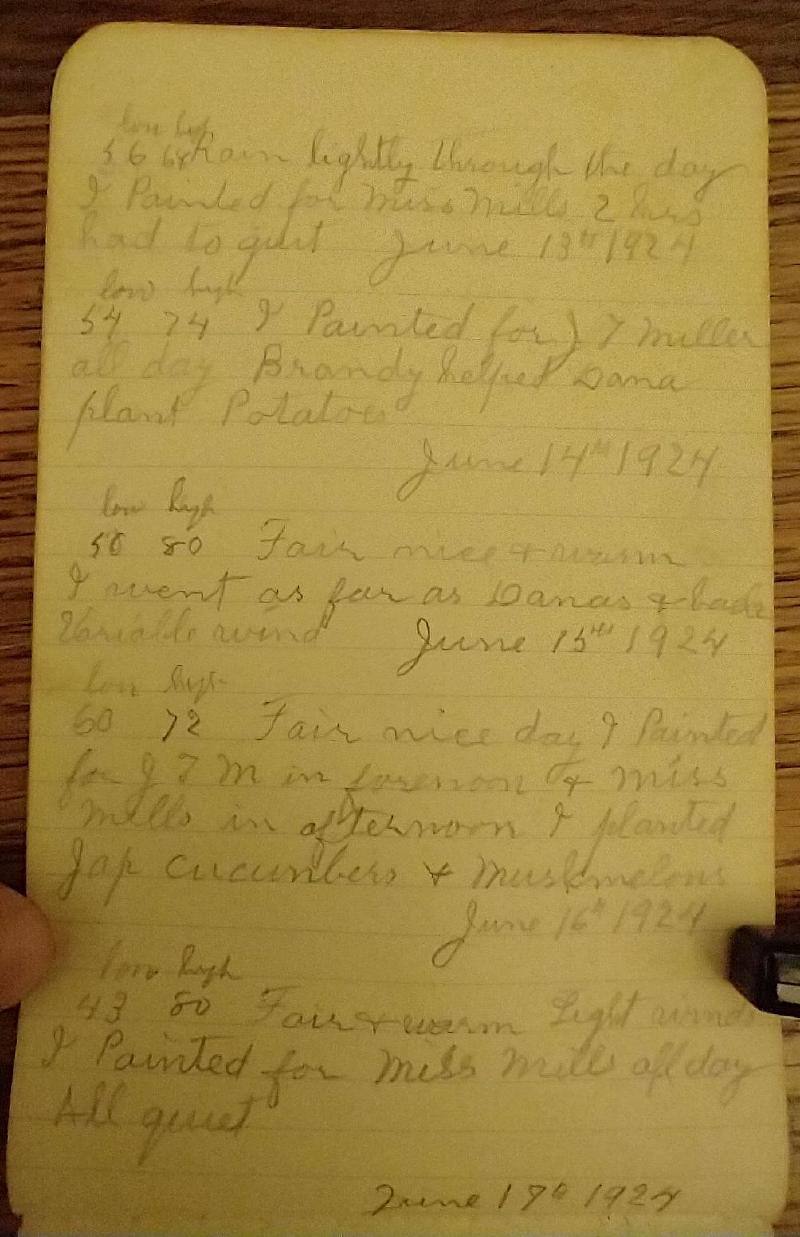
low 56 high 68 Rain lightly through the day I painted for Miss Mills 2 hrs had to quit.
June 13th 1924
low 54 high 74 I painted for J T Miller all day Brandy helped Dana plant potatoes
June 14th 1924
low 50 high 80 Fair nice & warm I went as far as Dana’s & back Variable wind
June 15th 1924
low 60 high 72 Fair nice day I painted for J T M in forenoon & Miss Mills in afternoon I planted Jap cucumbers & muskmelons
June 16th 1924
low 43 high 80 Fair & warm light winds I painted for Miss Mills all day All quiet
June 17th 1924
— Notebooks of George E. Jansen, Tompkins County History Center, Ithaca NY. View largest available size.
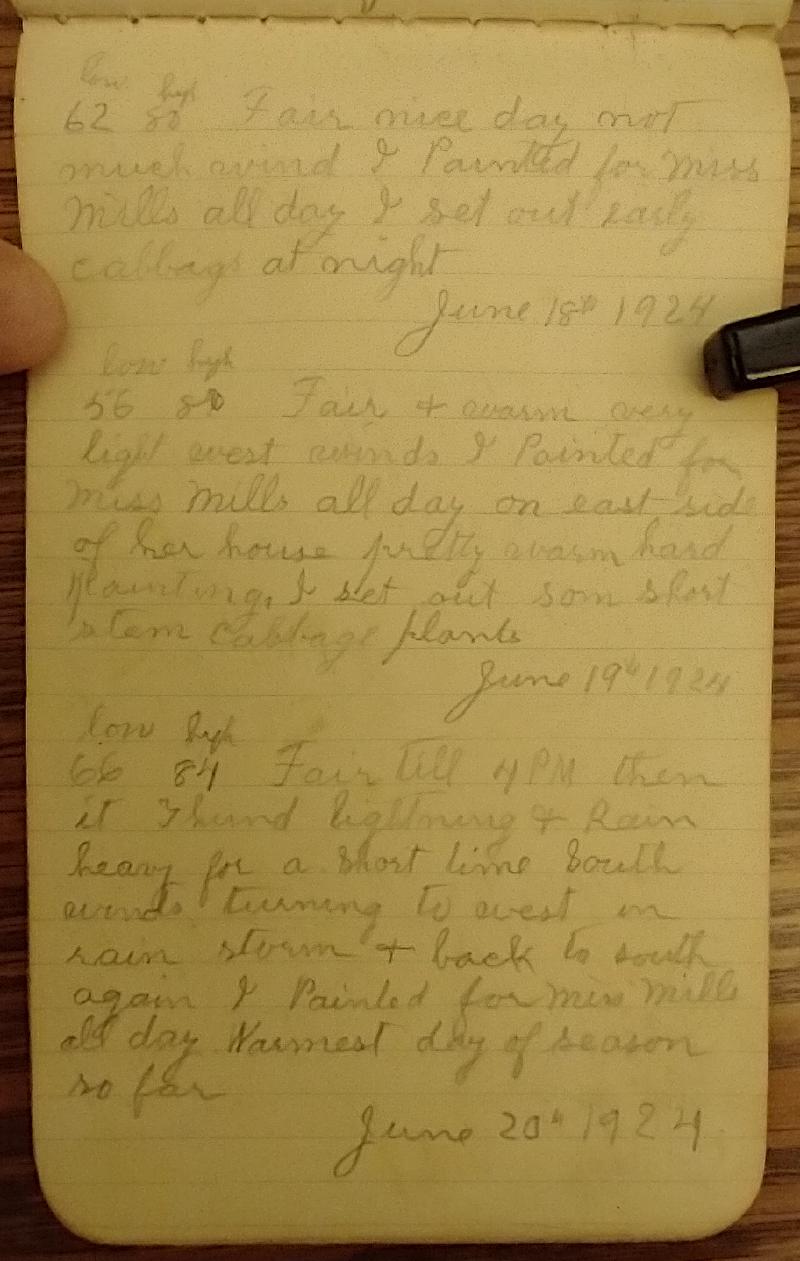
low 62 high 80 Fair nice day not much wind I painted for Miss Mills all day I set out early cabbage at night
June 18th 1924
low 56 high 80 Fair & warm very light west winds I painted for Miss Mills all day on east side of her house pretty warm hard painting. I set of some short stem cabbage plants
June 19th 1924
low 66 high 84 Fair till 4 PM then it thund lightning & rain heavy for a short time South winds turning to west in rain storm & back to south again I painted for Miss Mills all day Warmest day of season so far
June 20th 1924
— Notebooks of George E. Jansen, Tompkins County History Center, Ithaca NY. View largest available size.
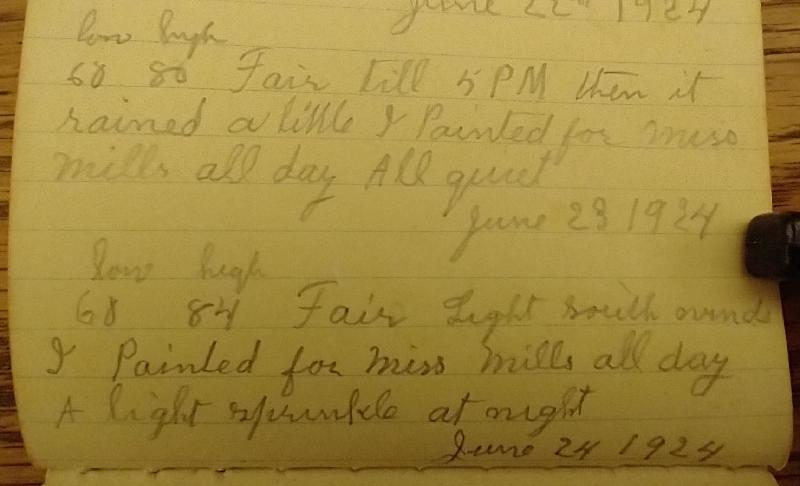
low 60 high 80 Fair till 5PM then it rained a little I painted for Miss Mills all day All quiet
June 23 1924
low 68 high 84 Fair light south winds I painted for Miss Mills all day A light sprinkle at night
June 24 1924
— Notebooks of George E. Jansen, Tompkins County History Center, Ithaca NY. View largest available size.
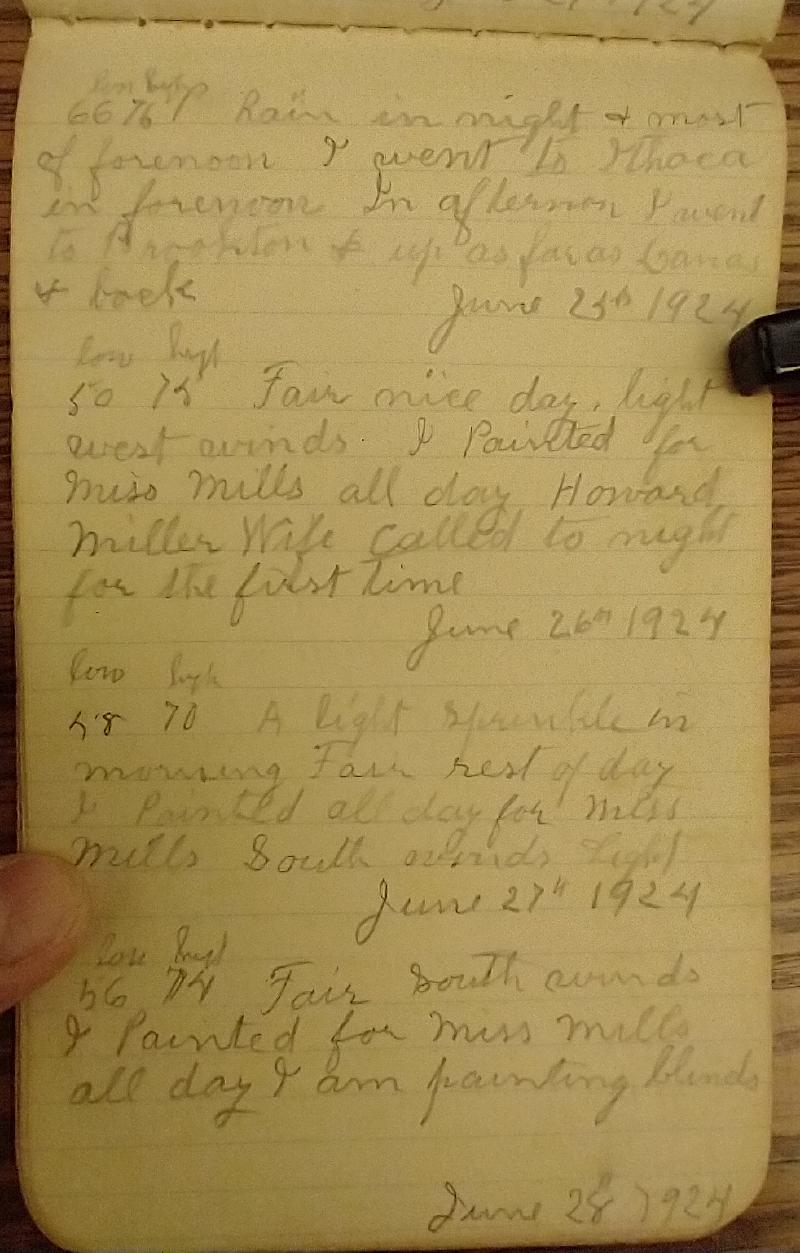
low 66 high 76 Rain in the night & most of forenoon I went to Ithaca in forenoon In afternoon I went to Brookton & up as far as Danas & back
June 25th 1924
low 50 high 75 Fair nice day. light west winds I painted for Miss Mills all day Howard Miller Wife called to night for the first time
June 26th 1924
low 58 high 70 A light sprinkle in morning Fair rest of day I painted all day for Miss Mills South winds light
June 27th 1924
low 56 high 74 Fair south winds I painted for Miss Mills all day I am painting blinds
June 28 1924
— Notebooks of George E. Jansen, Tompkins County History Center, Ithaca NY. View largest available size.
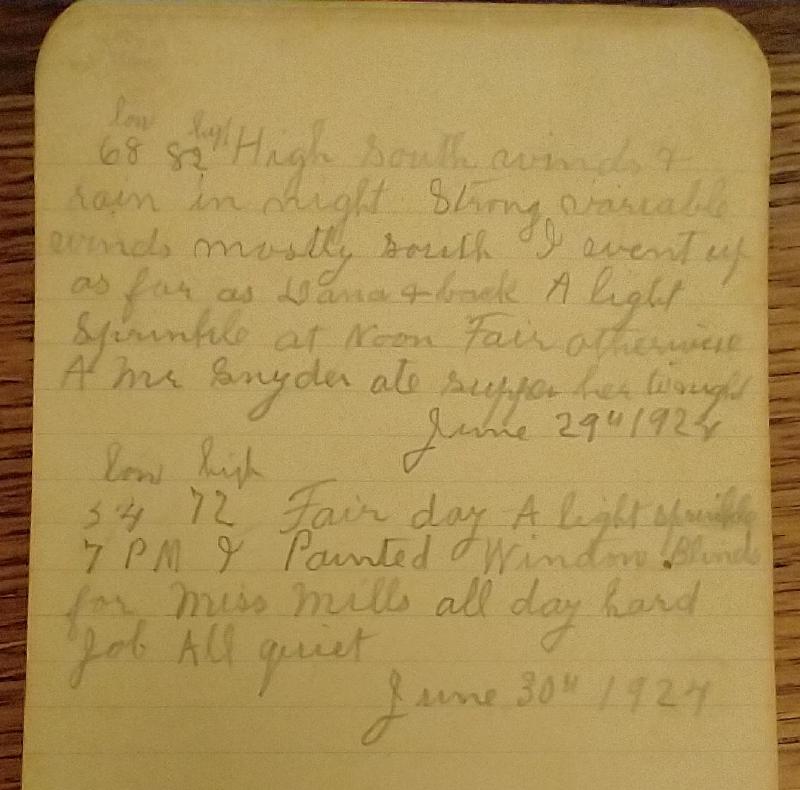
low 68 high 82 High south winds & rain in night Strong variable winds mostly south I went up as far as Dana & back A light sprinkle at Noon Fair otherwise A Mr Snyder ate supper here tonight
June 29th 1924
low 54 high 72 Fair day A light sprinkle 7 PM I painted window blinds for Miss Mills all day hard job All quiet
June 30th 1924
— Notebooks of George E. Jansen, Tompkins County History Center, Ithaca NY. View largest available size.

Painted for M E Mills 1924
June day day June 26th 1 11th 1" " 27th 1 12th 1" " 28th 1 16 1/2 " 30 1 17th 1 July 1st 1 18th 1 " 2nd 1 19th 1 " 3rd 1 20 1 23 1 24 1 Paid Paid
— Notebooks of George E. Jansen, Tompkins County History Center, Ithaca NY. View largest available size.
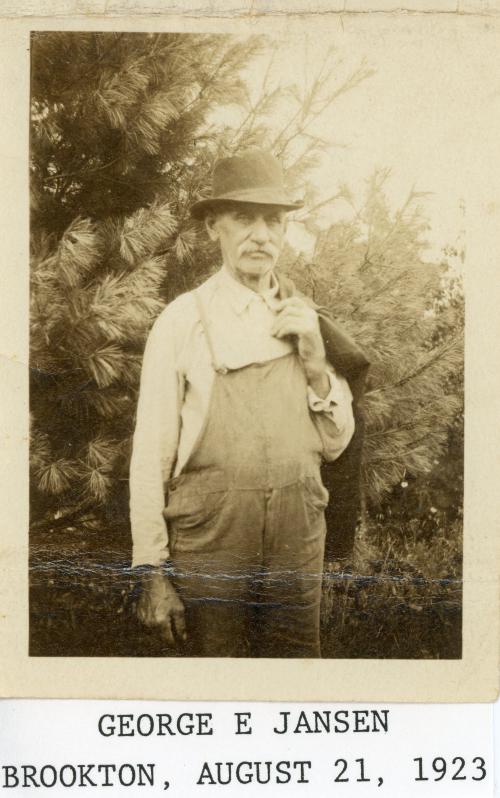
George E Jansen
Brookton, August 21, 1923
— Gertrude Conant Collection, Caroline History Room, Slaterville Springs NY. View largest available size.
George Jansen was also a member of High Bridge Lodge No. 296 of The Independent Order of Good Templars, Brookton NY at one time.
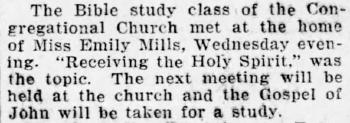
The Bible study class of the Congregational Church met at the home of Miss Emily Mills, Wednesday evening. “Receiving the Holy Spirit,” was the topic. The next meeting will be held at the church and the Gospel of John will be taken for a study.
— 10 May 1924, The Ithaca Journal, Ithaca NY, p11, newspapers.com. View largest available size.

The Bible study class of the Congregational Church will meet with Miss Emily Mills tomorrow evening at 7:30. All in this village who may be interested in God’s Word are welcome.
— 14 Oct 1924, The Ithaca Journal, Ithaca NY, p10, newspapers.com. View largest available size.

Mrs. Ellen Gould, who has been spending a month’s vacation at Valois, Pittsford and several other places, has returned to her home with Miss Emily Mill.
— 04 Sep 1924, The Ithaca Journal, Ithaca NY, p12, newspapers.com. View largest available size.
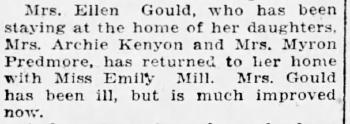
Mrs. Ellen Gould, who has been staying at the home of her daughters, Mrs. Archie Kenyon and Mrs. Myron Predmore, has returned to her home with Miss Emily Mill. Mrs. Gould has been ill, but is much improved now.
— 14 Jan 1925, The Ithaca Journal, Ithaca NY, p14, newspapers.com. View largest available size.

The many friends of Mrs. Ellen Gould are pleased to hear she has recovered from her fall and will soon be back to her home with Miss Emily Mills.
— 11 Mar 1925, The Ithaca Journal, Ithaca NY, p12, newspapers.com. View largest available size.
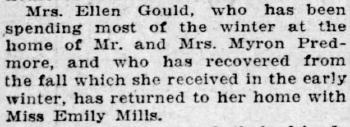
Mrs. Ellen Gould, who has been spending most of the winter at the home of Mr. and Mrs. Myron Predmore, and who has recovered from the fall which she received in the early winter, has returned to her home with Miss Emily Mills.
— 08 Apr 1925, The Ithaca Journal, Ithaca NY, p12, newspapers.com. View largest available size.

Mrs. Ellen Gould, who spent a few days last week in Ithaca, has returned to her home at Miss M. E. Mills.
— 17 Dec 1925, The Ithaca Journal, Ithaca NY, p14, newspapers.com. View largest available size.

The Baptist prayer meeting will be held Thursday evening at 8 o’clock with Mrs. Ellen Gould at the home of Miss M. E. Mills. All who are interested in prayer service are cordially invited.
— 12 Jan 1926, The Ithaca Journal, Ithaca NY, p10, newspapers.com. View largest available size.

Dr. and Mrs. B. F. Lockwood, who have been living over the M. E. Mills’ store since May 1, have moved back into their reconstructed home.
— 30 Oct 1926, The Ithaca Journal, Ithaca NY, p14, newspapers.com. View largest available size.

Fund To Aid Stricken Now Up To $4,456
Contributions Received Over Week-end to Red Cross Relief Drive Indicate Tompkins County May Reach Allotted Quota of $6,000
… Miss M. E. Mills……….1.00 …
(Partial transcription. Click on full size image to view complete text of article.)
— 02 Feb 1931, The Ithaca Journal, Ithaca NY, p5, newspapers.com. View largest available size.

Christmas seals are for sale by Mrs. Charles Mulks, Miss Emily Mills and Mrs. Tillie McWhorter.
— 05 Dec 1935, The Ithaca Journal, Ithaca NY, p19, newspapers.com. View largest available size.

June 24—Brooktondale—Meeting of Congregational Church Ladies Aid in hall over Miss Mills’ store to tie quilt.
— 22 Jun 1936, The Ithaca Journal, Ithaca NY, p2, newspapers.com. View largest available size.
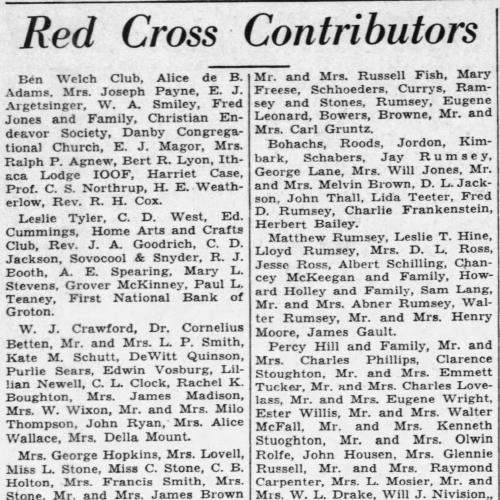
Red Cross Contributors
… Flora Root, Miss Emily Mills, Hermon Van Demark, Mr. and Mrs. Luther Teeter, Mr. and Mrs. Charles Teeter, Laurence Rosencrance, Mr. and Mrs. Laurence Marshall, Mr. and Mrs. Russell Fish, Mary Freeze, Schhoeders, Currys, Ramsey and Stones, Rumsey, Eugene Leonard, Bowers, Browne, Mr. and Mrs. Carl Gruntz. …
(Partial transcription, emphasis added. Click on full size image to view complete text of article.)
— 09 Feb 1937, The Ithaca Journal, Ithaca NY, p14, newspapers.com. View largest available size.
Emily fell and broke her hip while on her way to services at Brooktondale Congregational Church on 10 Oct 1937. She spent the last several weeks of her life in Memorial Hospital in Ithaca where she died on 03 November, a few weeks shy of 79 years old. Presumably, she was the first in her family not to die at home (with the possible exception of Horace). Like her father, Emily died without a will.

Miss Emily Mills, 80, fell and broke her hip last Sunday. Miss Mills has kept a store in the village of Brooktondale for many years.
— 15 Oct 1937, The Ithaca Journal, Ithaca NY, p13, newspapers.com. View largest available size.

Miss Emily Mills fell Oct. 10 while on her way to church, and broke her hip. She is in the Memorial Hospital, doing as well as could be expected.
— 20 Oct 1937, The Ithaca Journal, Ithaca NY, p9, newspapers.com. View largest available size.
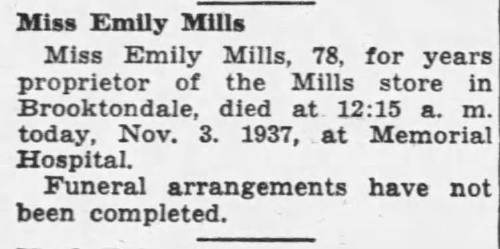
Miss Emily Mills
Miss Emily Mills, 78, for years proprietor of the Mills store in Brooktondale, died at 12:15 a. m. today, Nov. 3, 1937, at Memorial Hospital.
Funeral arrangements have not been completed.
— 03 Nov 1937, The Ithaca Journal, Ithaca NY, p2, newspapers.com. View largest available size.

Miss Emily Mills
Funeral services for Miss Emily Mills of Brooktondale who died Wednesday, Nov. 3, 1937, at Memorial Hospital, will be held at 2 p. m. Saturday at the First Congregational Church in Brooktondale. The Rev. Ralph Williamson will officiate. Interment will be at Quick Cemetery in Brooktondale.
— 04 Nov 1937, The Ithaca Journal, Ithaca NY, p3, newspapers.com. View largest available size.
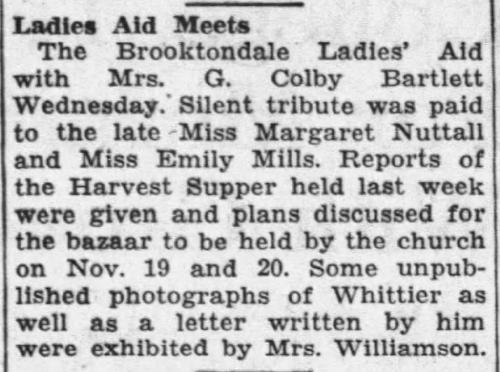
Ladies Aid Meets
The Brooktondale Ladies’ Aid with Mrs. G. Colby Bartlett Wednesday. Silent tribute was paid to the late Miss Margaret Nuttall and Miss Emily Mills. Reports of the Harvest Supper held last week were given and plans discussed for the bazaar to be help by the church on Nov. 19 and 20. Some unpublished photographs of Whittier as well as a letter written by him were exhibited by Mrs. Williamson.
— 05 Nov 1937, The Ithaca Journal, Ithaca NY, p17, newspapers.com. View largest available size.
This moving tribute was authored by E. D. Shurter, a Brookton native who was at different times, an attorney, a college professor and a nationally renowned orator and author. This is Emily’s only known obituary and is referenced elsewhere as such:
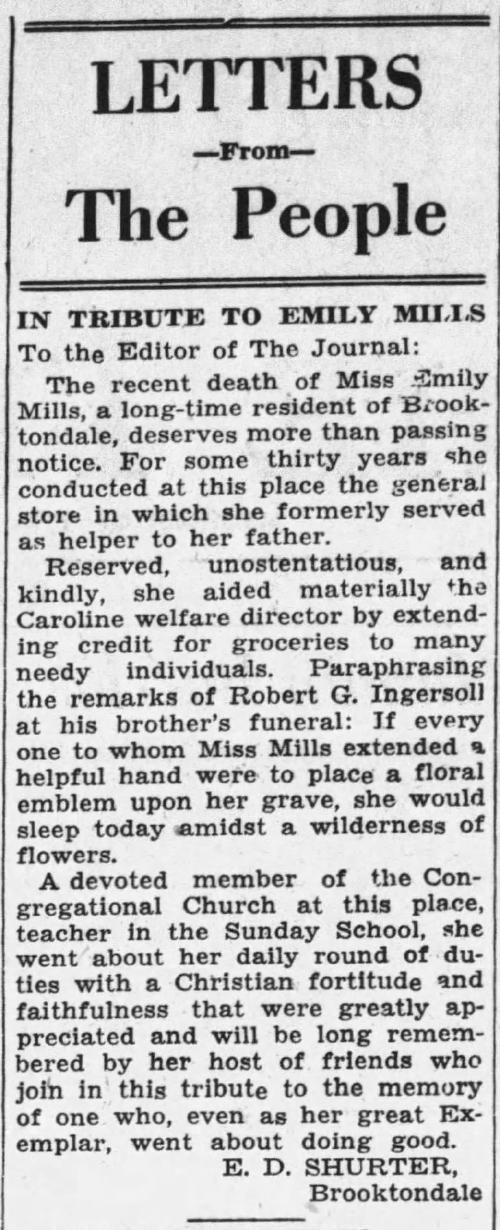
IN TRIBUTE TO EMILY MILLS
To the Editor of The Journal:
The recent death of Miss Emily Mills, a long-time resident of Brooktondale, deserves more than passing notice. For some thirty years she conducted at this place the general store in which she formerly served as helper to her father.
Reserved, unostentatious, and kindly, she aided materially the Caroline welfare director by extending credit for groceries to many needy individuals. Paraphrasing the remarks of Robert G. Ingersoll at his brother’s funeral: If everyone to whom Miss Mills extended a helpful hand were to place a floral emblem upon her grave, she would sleep today amidst a wilderness of flowers.
A devoted member of the Congregational Church at this place, teacher in the Sunday School, she went about her daily round of duties with a Christian fortitude and faithfulness that were greatly appreciated and will be long remembered by her host of friends who join in this tribute to the memory of one who, even as her great Exemplar, went about doing good.
E. D. Shurter, Brooktondale
— 11 Nov 1937, The Ithaca Journal, Ithaca NY, p2, newspapers.com. View largest available size.
The Professor clearly took great care in crafting this tribute, and with the pacing of the final sentence, one can sense the weight of responsibility he felt representing the sense of loss of an entire community who held Emily in equally high esteem. He is Emily’s first and most eloquent biographer, without whom we wouldn’t fully appreciate some of the most important aspects of Emily’s life, most notably, her charitable acts.
Although Robert Ingersoll was agnostic, his social views were likely quite similar to Emily’s, and so, the Professor’s inspiration was especially appropriate. Note the many parallels with Robert Ingersoll’s heartfelt eulogy for his brother, delivered a few months after the Mills family moved to Mott’s Corners:
A TRIBUTE TO EBON C. INGERSOLL. *
Washington, D. C., May 31, 1879.
DEAR FRIENDS: I am going to do that which the dead oft promised he would do for me.
The loved and loving brother, husband, father, friend, died where manhood’s morning almost touches noon, and while the shadows still were falling toward the west.
He had not passed on life’s highway the stone that marks the highest point; but being weary for a moment, he lay down by the wayside, and using his burden for a pillow, fell into that dreamless sleep that kisses down his eyelids still. While yet in love with life and raptured with the world, he passed to silence and pathetic dust.
Yet, after all, it may be best, just in the happiest, sunniest hour of all the voyage, while eager winds are kissing every sail, to dash against the unseen rock, and in an instant hear the billows roar above a sunken ship. For whether in mid-sea or ‘mong the breakers of the farther shore, a wreck at last must mark the end of each and all. And every life, no matter if its every hour is rich with love and every moment jeweled with a joy, will, at its close, become a tragedy as sad and deep and dark as can be woven of the warp and woof of mystery and death.
This brave and tender man in every storm of life was oak and rock; but in the sunshine he was vine and flower. He was the friend of all heroic souls. He climbed the heights, and left all superstitions far below, while on his forehead fell the golden dawning of the grander day.
He loved the beautiful, and was with color, form, and music touched to tears. He sided with the weak, the poor, and wronged, and lovingly gave alms. With loyal heart and with the purest hands he faithfully discharged all public trusts.
He was a worshiper of liberty, a friend of the oppressed. A thousand times I have heard him quote these words: “For Justice all place a temple, and all season, summer.” He believed that happiness is the only good, reason the only torch, justice the only worship, humanity the only religion, and love the only priest. He added to the sum of human joy; and were every one to whom he did some loving service to bring a blossom to his grave, he would sleep tonight beneath a wilderness of flowers.
Life is a narrow vale between the cold and barren peaks of two eternities. We strive in vain to look beyond the heights. We cry aloud, and the only answer is the echo of our wailing cry. From the voiceless lips of the unreplying dead there comes no word; but in the night of death hope sees a star and listening love can hear the rustle of a wing.
He who sleeps here, when dying, mistaking the approach of death for the return of health, whispered with his latest breath, “I am better now.” Let us believe, in spite of doubts and dogmas, of fears and tears, that these dear words are true of all the countless dead.
The record of a generous life runs like a vine around the memory of our dead, and every sweet, unselfish act is now a perfumed flower.
And now, to you, who have been chosen, from among the many men he loved, to do the last sad office for the dead, we give his sacred dust.
Speech cannot contain our love. There was, there is, no gentler, stronger, manlier man.
* The funeral of the Hon. E. C. Ingersoll took place yesterday afternoon at four o’clock, from his late residence, 1403 K Street. The spacious parlors were filled to overflowing, and hundreds were unable to obtain admittance. Among those who were present to pay their homage to the distinguished and beloved dead were Secretary of the Treasury Sherman, Assistant-Secretary of the Treasurer Hawley, Senators Blaine, Voorhees, Paddock, David Davis, John A. Logan, the Hon. William M. Morrison, Hon. William M. Springer, Hon. Thomas A. Boyd, Governor Pound, Hon. J. R. Thomas, Hon. Thomas J. Henderson, Hon. Jeremiah Wilson, Hon. Adlai E. Stevenson, Col. War H. Lamon, Col. James Fishback, General Farnsworth, General Robert C. Schenck, General Jeffries, General Williams and the Hon. H. C. Burchard. Judge Shellabarger, General Birney, Governor Lowe, Acting Commissioner of Internal Revenue H. C. Rogers, General Williamson of the Land Office and a great many other prominent members of the bar and also a large number of Illinoisans were present. It was the largest gathering of the distinguished persons assembled at a funeral since that of Chief-Justice Chase.
The only ceremony at the house, other than the viewing of the remains, was a most affecting pathetic, and touching address by Col. Robert G. Ingersoll, brother of the deceased. Not only the speaker, but every one of his hearers were deeply affected. When he began to read his eloquent characterization of the dead man his eyes at once filled with tears. He tried to hide them, but he could not do it, and finally he bowed his head upon the dead man’s coffin in uncontrollable grief. It was only after some delay, and the greatest efforts a self-mastery, that Colonel Ingersoll was able to finish reading his address. When he had ceased speaking, the members of the bereaved family approached the casket and looked upon the form which it contained, for the last time. The scene was heartrending. The devotion of all connected with the household excited the sympathy of all and there was not a dry eye to be seen. The pall-bearers—Senator William B. Allison, Senator James G. Blaine, Senator David Davis, Senator Daniel W. Voorhees. Representative James A. Garfield, Senator A. S. Paddock, Representative Thomas Q. Boyd of Illinois, the Hon. Ward H. Lamon, ex-Congressman Jere Wilson, and Representative Adlai E. Stevenson of Illinois—then bore the remains to the hearse, and the lengthy cortege proceeded to the Oak Hill Cemetery, where the remains were interred, in the presence of the family and friends, without further ceremony.- National Republican, Washington, D. C., June 3, 1879.
— 1901, The Works of Robert G. Ingersoll, The Dresden Publishing Co., New York, v12, p389-391. Emphasis added.
The news clippings above give examples of Emily’s charitable acts, such as her contributions to the Red Cross, and of course, the W.C.T.U. did considerable charitable work. In the M. E. Mills store sales journals, there are entries indicating direct donations from the store that Emily counted against her own account as “Goods for Charity”:
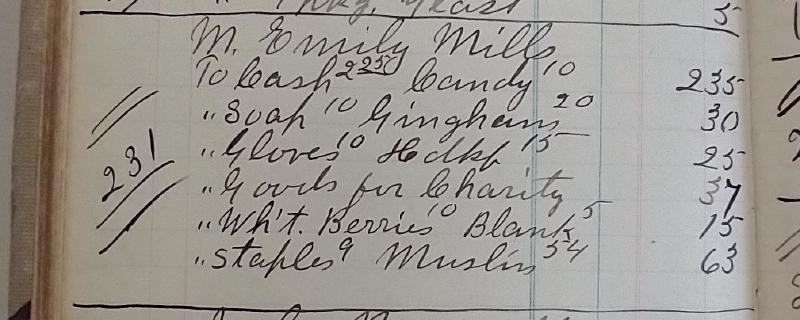
— 26 Mar 1909, E. H. Mills Store Sales Journal No. 41, p554 digital photograph of book owned by Brooktondale collector. View largest available size.
There are also entries in the historical records of Caroline Valley Federated Church of extra donations made to the church by both Hannah and Emily among other members. By agreement with the Church, I have not reproduced any financial records here.

Another petition was filed by Fred D. Gilbert of Ithaca for a letter of administration on the estate of Mary Emily Mills, late of Brooktondale, who left $400 personal and $1200 real property.
— 26 Nov 1937, The Ithaca Journal, Ithaca NY, p9, newspapers.com. View largest available size.

THE PEOPLE OF THE STATE OF NEW YORK — BY THE GRACE OF GOD FREE AND INDEPENDENT:
To Alonzo Mills, George Mills, Clarissa Etsal, Robert Mills and Mary Huntting Smith and any other heirs or distributees of Mary Emily Mills deceased, whose names, residences and post office addresses are unknown to petitioner and cannot with due diligence be ascertained and to all persons interested in the estate of Mary Emily Mills late of the town of Caroline, Tompkins County, State of New York, deceased, as creditors, legatees, devisees, heirs at law, next of kin, distributees or otherwise, on the petition of Fred D. Gilbert of the city of Ithaca Tompkins County, N. Y.
SEND GREETING:
You and each of you are hereby cited and required to show cause before our Surrogate, in Surrogate’s Court in and for the County of Tompkins, at his office in the City of Ithaca, N. Y., on the 21st day of December, 1937, at 10 o’clock in the forenoon of that day why Charles Thomas, a creditor, should not be appointed Administrator of the goods, chattels and credits of Mary Emily Mills, deceased and for such other or different relief as is just.
And those of you who are under the age of twenty-one years, will each please take notice that you are required to appear by your general guardian, if you have one, or if you have none, you will appear and apply for the appointment of a guardian, or in the event of your neglect or failure to do so, a special guardian will be appointed by the Surrogate to represent and act for you in this proceeding.
IN TESTIMONY WHEREOF, We have caused the Official Seal of our said Surrogate’s Court of Tompkins County to be hereunto affixed. WITNESS, HON WILLARD M. KENT, Surrogate of the County of Tompkins, (L.S.) at the Surrogate’s office in the City of Ithaca, this 24th day of November, in the year of our Lord, one thousand, nine hundred and thirty-seven.
D. M. Gillespie Clerk of Surrogate’s Court. Monroe M. Sweetland, Attorney, Ithaca, N. Y.
— 15 Dec 1937, Tompkins County Rural News, Dryden NY, p7, fultonhistory.com. View largest available size.

Auctions
JAN. 21, 22, FRIDAY AND SATURDAY-12:30 p. m. each day the undersigned administrator will sell at Public Auction the Mary Emily Mills Estate, Brooktondale, N. Y., entire household goods, consisting of beds, bedding, rugs, dishes, chairs, quantity of antiques will be sold Friday. Entire contents of store; large line of general merchandise: dry goods, underwear, overalls, shirts, quantity of hardware. On Sat. p. m. I will offer for sale the house and lot of said M. E. Mills. Bids will be accepted subject to approval of court. Terms, cash. Charles Thomas. administrator and auctioneer. R. G. Fuller, clerk.
— 19 Jan 1938, The Ithaca Journal, Ithaca NY, p15, newspapers.com. View largest available size.

THE PEOPLE OF THE STATE OF NEW YORK—BY THE GRACE OF GOD FREE AND INDEPENDENT:
To Alonzo Mills, Clarissa Etsal, Mary Hunting Smith, George Mills, and all the other heirs and distributees, if any, of said Mary Emily Mills whose names, residences and addresses are unknown to petitioner and cannot with due diligence be ascertained; Mrs. Jessie Brewer, Mrs. Rena Kirk, Mrs. Martha Whitley, R. S. Fuller, H. Beardsley, Ithaca Journal News, Lewis Brewer, Elmer Lockwood, Fred D. Gilbert, Bert Eastman, T. G. Miller Sons, Quick Cemetery, New York State Electric and Gas Inc.; E. C. Campbell Co.; Tompkins County Memorial Hospital; Albert Landen, Baker Rose & Kimbull, Binghamton Jobbing Co., J. C. Stowell Co., Proctor Gamble Co., Dr. R. M. Vose and Dr. Mary Ridgeway,
And to all persons interested in the estate of Mary Emily Mills late of the Town of Caroline, Tompkins County, State of New York, deceased, as creditors, legatees, devisees, heirs at law, next of kin, distributees or otherwise, on the petition of Charles Thomas of the Town of Caroline, Tompkins County, N. Y.
SEND GREETING:
You and each of you are hereby cited and required to show cause before our Surogate, in Surrogate’s Court in and for the the County of Tompkins, at his office in the City of Ithaca, N. Y., on the 26th day of July 1938, at 10 o’clock in the forenoon of that day why a decree should not be made to mortgage, lease or sell the real property of Mary Emily Mils, deceased, who at the time of her death resided at Brooktondale, in the Town of Caroline, Tompkins County, N. Y., for the payment of the debts and funeral expenses of said deceased, and to further show cause why the accounts and proceedings of Charles Thomas as administrator of the goods, chattels credits of said Mary should not be finally settled and the net proceeds of said estate distributed among those entitled to receive the same, and for such other or different relief as is just herein.
And those of you who are under the age of twenty-one years, will each please take notice that you are required to appear by your general guardian, if you have one, or if you have none, you will appear and apply for the appointment of a guardian, or in the event of your neglect or failure to do so, a special guardian will be appointed by the Surrogate to represent and act for you in this proceeding.
IN TESTIMONY WHEREOF, We have caused the Official Seal of our said Surrogate’s Court of Tompkins County to be hereunto affixed. WITNESS, HON. WILLARD M. KENT, Surrogate of the County of Tompkins, at the Surrogate’s office in the City of Ithaca, this 28th day of June, in the year of our Lord, one thousand, nine hundred and thirty-eight.
D. M. Gillespie,
Clerk of Surrogate’s Court. Monroe M. Sweetland, Attorney, Ithaca, N. Y.
— 06 Jul 1938, Tompkins County Rural News, Dryden NY, p6, fultonhistory.com. View largest available size.
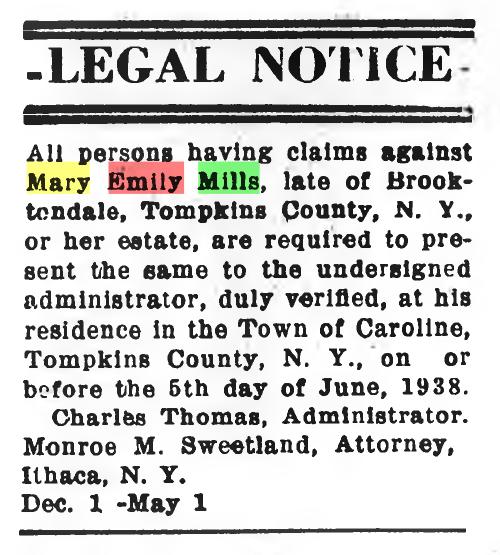
-LEGAL NOTICE-
All persons having claims against Mary Emily Mills, late of Brooktondale, Tompkins County, N. Y., or her estate, are required to present the same to the undersigned administrator, duly verified, at his residence in the Town of Caroline, Tompkins County, N. Y., on or before the 5th day of June, 1938.
Charles Thomas, Administrator. Monroe M. Sweetland, Attorney, Ithaca, N. Y.
Dec. 1 -May 1
— 09 Dec 1938, Tompkins County Rural News, Dryden NY, p6, fultonhistory.com. View largest available size.
Emily was the last in the line of Edward H. Mills, and it seems that her family’s story has become unknown to the Mills of subsequent generations.
Emily is interred at Brookton (formerly Quick) Cemetery at the corner of Landon Road and Lounsbery Road in Brooktondale NY, 14817.
As one is standing in front of the Emily’s headstone, with back to the cemetery entrance on Lounsbery Road, the ground is disturbed on the left side of the two plots purchased for Emily, indicating where she rests. As is the case with Hannah, the date of birth on Emily’s headstone is incorrect:
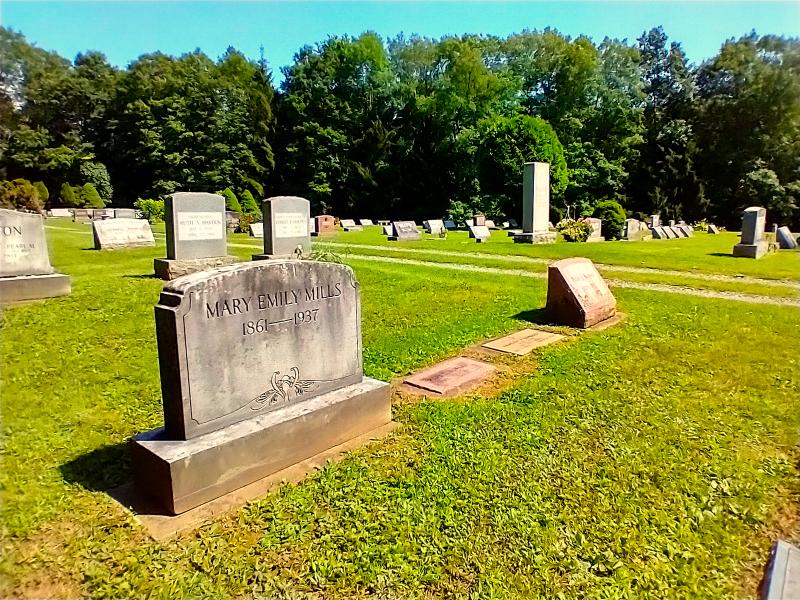
— feature. View largest available size.
As already shown above, Emily was baptized at the Reformed Dutch Church on Staten Island on 30 Nov 1859, and Emily is listed with her family in the 1860 Federal Census:
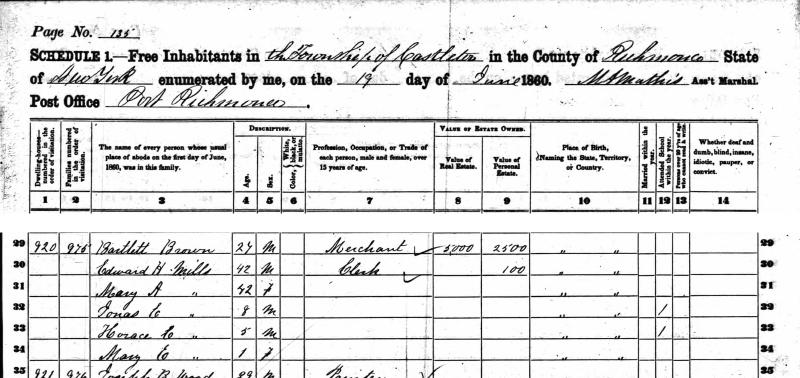
— 19 Jun 1860, United States Federal Census, Castleton NY, p135, ancestry.com. View largest available size.
Furthermore, in her entry in the 1900 US census, Emily indicates her birth date is “Dec 1858”. The census data I have seen is presently limited to what is available online through ancestry.com, but among those I was able to find during Emily’s lifetime, only the 1900 census asked for month and year of birth, while all others, including 1900, simply ask for age at last birthday. Census’ were typically done in May or June of the appropriate years, and Emily’s self reported age in each census consistently resolves to 1858 as indicated in the “Computed birthyear” column in the census data summary shown above.

— 13 Jun 1900, United States Federal Census, Caroline NY, p4, ancestry.com. View largest available size.
I have been in contact with two people at Brookton Cemetery who have both looked into the matter, and they each confirmed that the only information they have on Emily is the name and plot number “and what is on the headstone”. There is no indication who made the funeral arrangements for Emily, who the plot was sold to, or any information that might shed light on the erroneous birth year. Emily’s grave stone is the only documentation I have with this birth year other than subsequent histories that were written using the grave stone as the source for her birth year.
That the birth year on Emily’s grave is incorrect suggests Emily’s final arrangements were made by one or more people in Brooktondale, likely someone from the Congregational Church, Jessie Brewer being the most likely candidate, although E. D. Shurter is another possibility. This further implies that Emily no longer had contact with any Mills family descendants on Long Island, which seems to be supported by the potential heirs sought out after her death as noted in the Mills’ home deeds.
Further research will obviously need to be done, but ultimately, Emily’s exact date of birth (and that of her brothers) may be lost, as she was born during a notoriously bad period for the recording and preservation of birth records. In addition to the usual sources, I submitted a reference question to the staff of the Presbyterian Historical Society, but they were unable to find records for Mary Ann or her children. (Much of the Church’s digitized records are actually available via ancestry.com, and in fact, entries can be round for Edward’s sister Emily Tabitha Mills for example.) I have also submitted requests to the New York State Department of Health vital records as well as the New York City Department of Records and Information Services, and in both cases so records for Emily’s birth were found. It is interesting to note however that according to ldsgenealogy.com, there are potentially many microfilm records for Richmond County (Staten Island) during this time period.
Other Historical Accounts
Understandably, previous historical references to the Mills family have typically focused on Emily and her store. All previous secondary sources of information on Emily accepted 1861 as her birth year, which I have presented overwhelming documentary evidence disproving.
Shortly after I moved into the Mills’ home in Brooktondale, Molly Adams visited me to sign me up for the Old Mill newsletter, and to give me the following history of Emily Mills and her store. I have since been told that this was a ritual Molly performed with other Brooktondale newcomers. Despite its title, this exceptional account is more about the M. E. Mills store than it is about Emily herself.
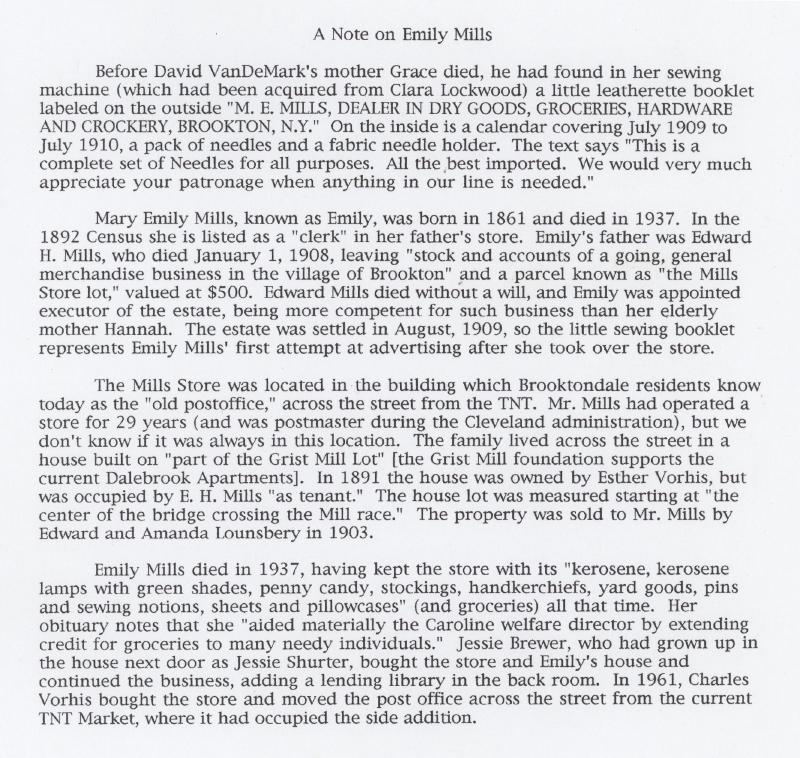
A Note on Emily Mills
Before David VanDeMark’s mother Grace died, he had found in her sewing machine (which had been acquired from Clara Lockwood) a little leatherette booklet labeled on the outside “M. E. MILLS, DEALER IN DRY GOODS, GROCERIES, HARDWARE AND CROCKERY, BROOKTON, N.Y.” On the inside is a calendar covering July 1909 to July 1910, a pack of needles and a fabric needle holder. The text says “This is a complete set of needles for all purposes. All the best imported. We would very much appreciate your patronage when anything in our line is needed.”
Mary Emily Mills, known as Emily, was born in 1861 and died in 1937. In the 1892 Census she is listed as a “clerk” in her father’s store. Emily’s father was Edward H. Mills, who died January 1, 1908, leaving “stock and accounts of a going, general merchandise business in the village of Brookton” and a parcel known as “the Mills Store lot,” valued at $500. Edward Mills died without a will, and Emily was appointed executor of the estate, being more competent for such business than her elderly mother Hannah, The estate was settled in August, 1909, so the little sewing booklet represents Emily Mills’ first attempt at advertising after she took over the store.
The Mills Store was located in the building which Brooktondale residents know today as the “old postoffice,” across the street from the TNT. Mr. Mills had operated a store for 29 years (and was postmaster during the Cleveland administration), but we don’t know if it was always in this location. The family lived across the street in a house built on “part of the Grist Mill Lot” [the Grist Mill foundation supports the current Dalebrook Apartments]. In 1891 the house was owned by Esther Vorhis, but was occupied by E. H. Mills “as tenant.” The house lot was measured starting at “the Center of the bridge crossing the Mill race.” The property was sold to Mr. Mills by Edward and Amanda Lounsbery in 1903.
Emily Mills died in 1937, having kept the store with its “kerosene, kerosene lamps with green shades, penny candy, stockings, handkerchiefs, yard goods, pins and sewing notions, sheets and pillowcases” (and groceries) all that time. Her obituary notes that she “aided materially the Caroline welfare director by extending credit for groceries to many needy individuals.” Jessie Brewer, who had grown up in the house next door as Jessie Shurter, bought the store and Emily’s house and continued the business, adding a lending library in the back room. In 1961, Charles Vorhis bought the store and moved the post office across the street from the current TNT Market, where it had occupied the side addition.
— Molly Adams. View largest available size.
Although I read this “Note” with some interest initially, I didn’t appreciate its importance until several years too late to ask Molly to teach me more. I at least had the foresight to save it somewhere I could find it again years later when I needed it. I revisit this often, still mining it for clues about Emily, trying to learn what Molly knew.
The answer to Molly’s question “and some groceries?” seems to be yes. Perhaps the question arose because Jessie Brewer apparently did not continue to sell groceries, and this was what residents of the time would more likely remember.
The Caroline History Room in Slaterville Springs NY has a collection of Molly Adams’ research notes in file folders, organized by people and property among other subjects. She had a folder of deed research into 475 Brooktondale Road, a folder dedicated to the Mills family, and there are a few drafts of her “Note” that all seem to be dated in the Spring of 2002. Although these versions largely repeat what is in the “Note” and elsewhere, they contain further historical context and most importantly, indicate the sources of the quotes in the “Note” as well as the fact that the “leatherette booklet” was accessioned by the Caroline History Room.
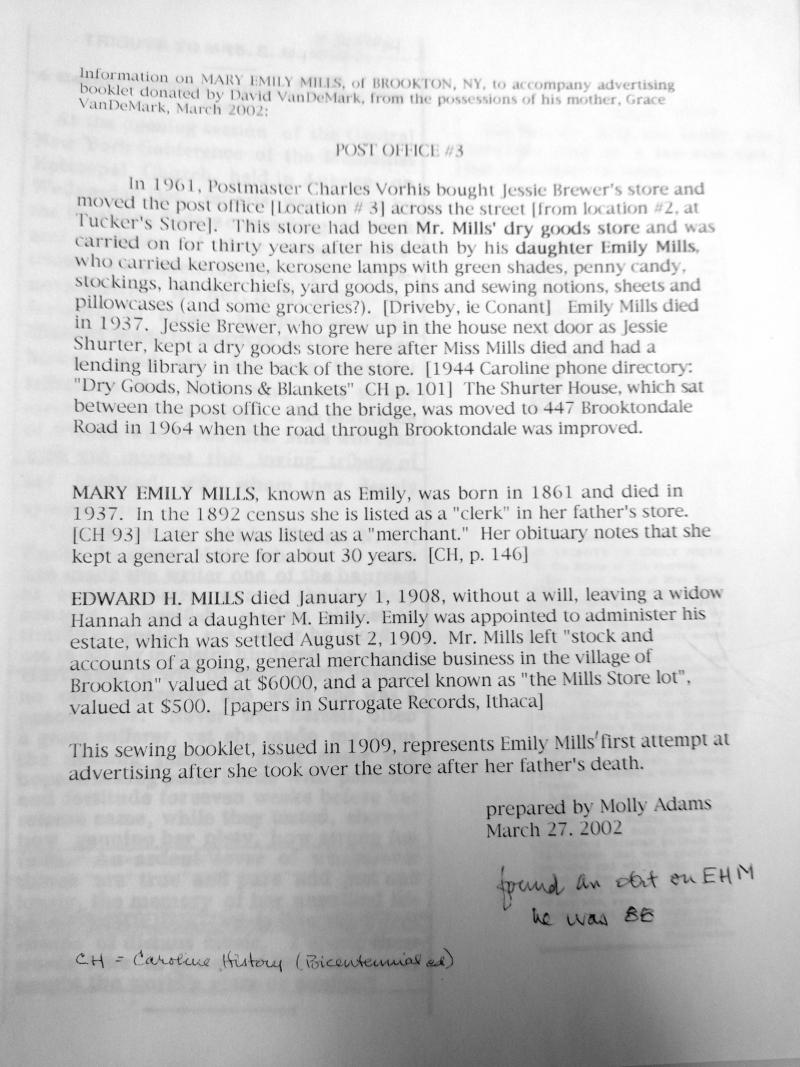
Information on MARY EMILY MILLS of BROOKTON, NY, to accompany advertising booklet donated by David VanDeMark, from the possessions of his mother, Grace VanDeMark, March 2002:
POST OFFICE #3
In 1961, Postmaster Charles Vorhis bought Jessie Brewer’s store and moved the post office [Location #3] across the street [from location #2, at Tucker’s Store]. This store had been Mr. Mills’ dry goods store and was carried on for thirty years after his death by his daughter Emily Mills, who carried kerosene, kerosene lamps with green shades, penny candy, stockings, handkerchiefs, yard goods, pins and sewing notions, sheets and pillowcases (and some groceries?). [Driveby, ie Conant] Emily Mills died in 1937. Jessie Brewer, who grew up in the house next door as Jessie Shurter, kept a dry goods store here after Miss Mills died and had a lending library in the back of the store. [1944 Caroline phone directory: “Dry Goods, Notions & Blankets” CH p. 101] The Shurter House, which sat between the post office and the bridge, was moved to 447 Brooktondale Road in 1964 when the road through Brooktondale was improved.
MARY EMILY MILLS, known as Emily, was born in 1861 and died in 1937. In the 1892 census she is listed as a “clerk” in her father’s store [CH 93] Later she was listed as a “merchant.” Her obituary notes that she kept a general store for about 30 years. [CH, p. 146]
EDWARD H. MILLS died January 1, 1908, without a will, leaving a widow Hannah and a daughter M. Emily. Emily was appointed to administer his estate, which was settled August 2, 1909. Mr. Mills left “stock and accounts of a going, general merchandise business in the village of Brookton” valued at $6000, and a parcel known as “the Mills Store lot”, valued at $500. [papers in Surrogate Records, Ithaca]
This sewing booklet, issued in 1909, represents Emily Mills’ first attempt at advertising after she took over the store after her father’s death.
prepared by Molly Adams
March 27, 2002
found an obit on EHM
he was 88
CH = Caroline History (Bicentennial ed)
— Molly Adams, Caroline History Room, Slaterville Springs NY. View largest available size.
The following appears to be written for publication, or possibly mailed to people to ask them for more information, which was also one of my main motivations for starting the memills.com website. Note that that item is numbered “7”, but I don’t know where this page might have originally come from.
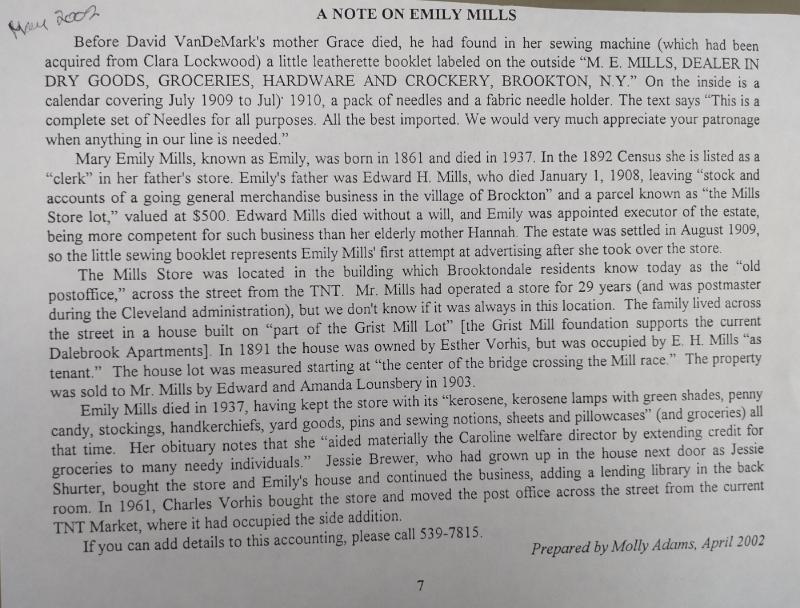
…
If you can add details to this accounting, please call 539-7815.
Prepared by Molly Adams, April 2002
7
— Molly Adams Collection, Caroline History Room, Slaterville NY. View largest available size.
Barbara Kone and others have searched the Caroline History Room for the “leatherette booklet” Molly mentioned, but it has not yet been found. Fortunately, Molly had the foresight to keep printed reproductions in her file folders:
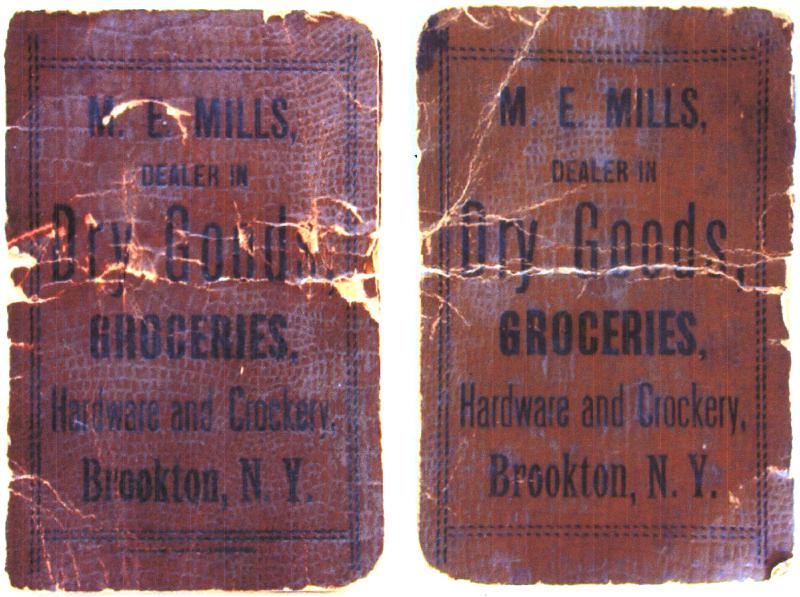
M. E. Mills,
Dealer in
Dry Goods,
Groceries,
Hardware and Crockery,
Brookton, N. Y.
— Molly Adams Collection, Caroline History Room, Slaterville NY. View largest available size.
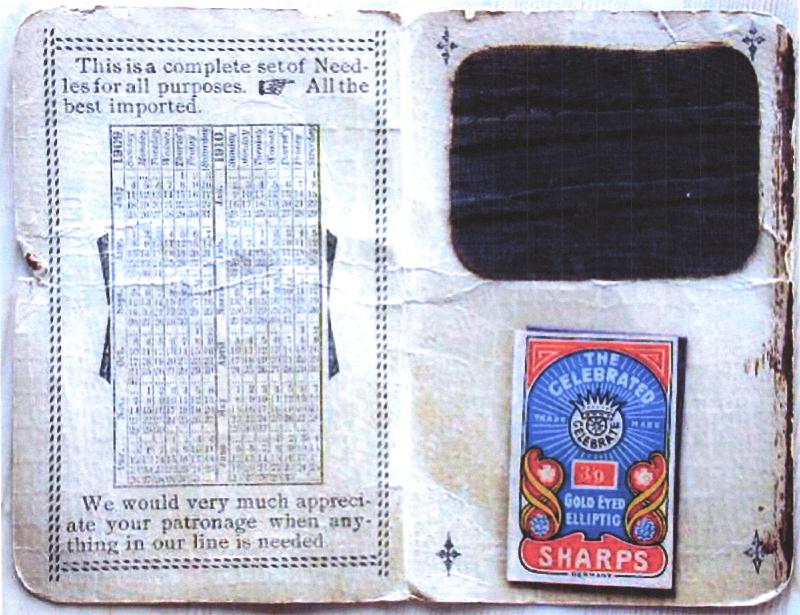
This is a complete set of Needles for all purposes. All The best imported.
[1909 and 1910 calendar]
We would very much appreciate your patronage when anything in our line is needed.
— Molly Adams Collection, Caroline History Room, Slaterville NY. View largest available size.
And Molly retained a printed reproduction of the following item; the location of the original is currently unknown to me:
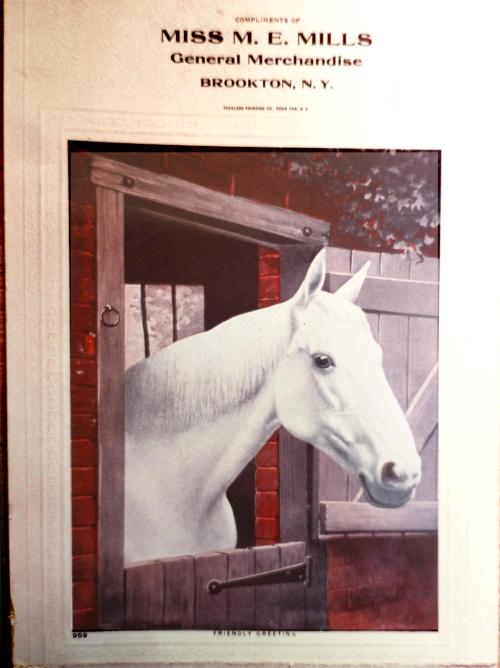
Compliments of
Miss M. E. Mills
General Merchandise
Brookton, N. Y.
Friendly Greeting
— Molly Adams Collection, Caroline History Room, Slaterville NY. View largest available size.
Emily is also mentioned twice by Molly Adams (1936 to 23 Jun 2014) in her chapter “Town of Caroline” in The Towns of Tompkins County: From Podunk to the Magnetic Springs edited by Jane Marsh Dieckmann:
…[George Jansen] noted the death of Emily Mills, who had continued her father’s store for thirty years, extending credit to many needy individuals.
— 1998, Molly Adams, “Town of Caroline” in The Towns of Tompkins County: From Podunk to the Magnetic Springs edited by Jane Marsh Dieckmann, p61-2.
As indicated elsewhere, George Jansen predeceased Emily by two years. The entry that Molly must have been referring to is the mention of Edward’s death:

— Notebooks of George E. Jansen, Tompkins County History Center, Ithaca NY.
Emily is mentioned in Town of Caroline Historian Barbara Kone’s compilation “A History of the Town of Caroline, Tompkins County, New York, United States of America” known to us all as “The Bicentennial Book.”
“A Drive-by Tour of the Town of Caroline” sponsored by the Town of Caroline Bicentennial Committee 1994-1995 contains a listing for M. E. Mills on a page identified as “Tour 4 - P7” in a 2016 reprint by The White Church Cabin Country Store and is the source (with some alterations) of the description Molly Adams used in her “Note”. In Molly’s research notes, she gives the attribution: “[Driveby, ie Conant]” and I confirmed with Barbara Kone that Gertrude wrote the Brooktondale portions of the “Drive-by” book:
BROOKTONDALE POST OFFICE, left – 484 Brooktondale Road
This was Miss Mary Emily Mills’(1861-1937) Dry Goods Store. She also had kerosene, Kerosene lamps with green shades, penny candy, stockings, handkerchiefs, yard goods, pins & sewing notions sheets & pillowcases, groceries, etc. She was a “sweet little lady” who succeeded her father in the business. Jessie Brewer had dry goods here after Miss Mills, and also had a lending library in the back.
The post office has moved at least 3 times. This is the 3rd site.Between the Post Office and the bridge sat the Shurter House which was moved.
Gertrude Conant’s personal recollections provide valuable details, including physical descriptions of Emily and her store as well as reflections on her personality. If not for Gertrude, these precious details would be long forgotten.
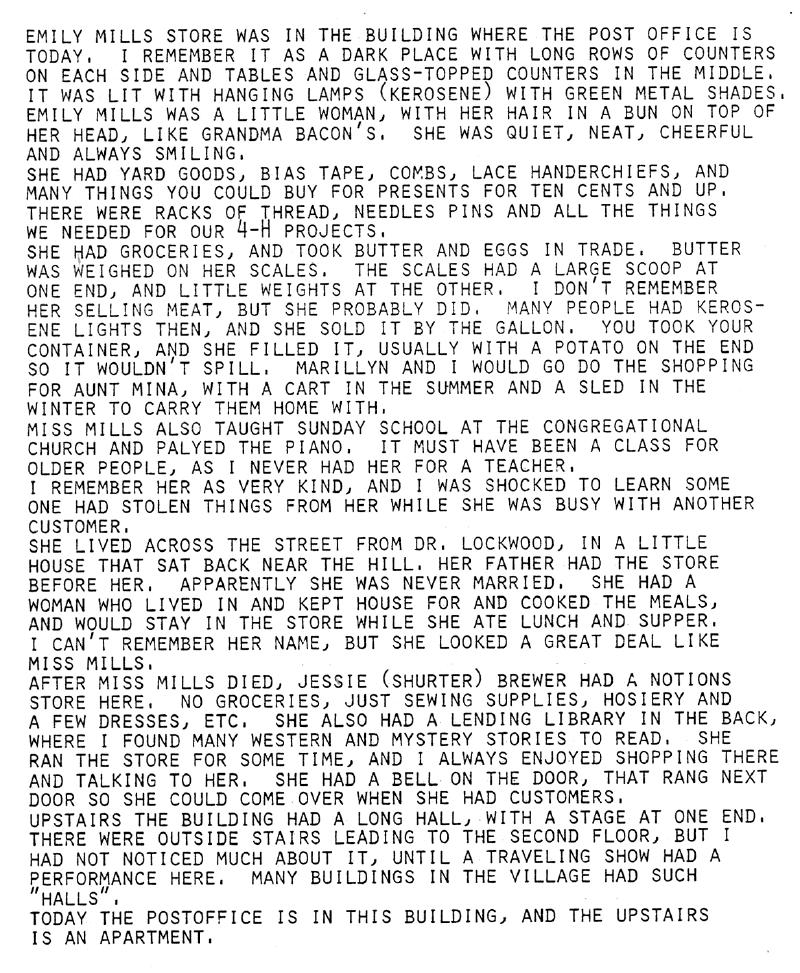
Emily Mills’ store was in the building where the Post Office is today. I remember it as a dark place with long rows of counters on each side and tables and glass-topped counters in the middle. Emily Mills was a little woman, with her hair in a bun on top of her head, like Grandma Bacon’s. She was quiet, neat, cheerful and always smiling.
She had yard goods, bias tape, combs, lace handerchiefs, and many things you could buy for presents for ten cents and up. There were racks of thread, needles, pins and all the things we needed for our 4-H projects.
She had groceries, and took butter and eggs in trade. Butter was weighed on her scales. The scales had a large scoop at one end, and little weights at the other. I don’t remember her selling meat, but she probably did. Many people had kerosene lights then, and she sold it by the gallon. You took your container, and she filled it, usually with a potato on the end so it wouldn’t spill. Marilyn and I would go do the shopping for Aunt Mina, with a cart in the Summer and a sled in the Winter to carry them home with.
Miss Mills also taught Sunday School at the Congregational Church and played the piano. It must have been a class for older people, as I never had her for a teacher.
I remember her as very kind, and I was shocked to learn someone had stolen things from her while she was busy with another customer.
She lived across the street from Dr. Lockwood, in a little house that sat back near the hill. Her father had the store before her. Apparently she never married. She had a woman who lived in and kept house for and cooked the meals, and would stay in the store while she ate lunch and supper. I can’t remember her name, but she looked a great deal like Miss Mills.
After Miss Mills died, Jessie (Shurter) Brewer had a notions store here. No groceries, just sewing supplies, hosiery and a few dresses, etc. She also had a lending library in the back, where I found many western and mystery stories to read. She ran the store for some time, and I always enjoyed shopping there and talking to her. She had a bell on the door, that rang next door so she could come over when she had customers.
Upstairs the building had a long hall, with a stage at one end. There were outside stairs leading to the second floor, but I had not noticed much about it, until a traveling show had a performance here. Many buildings in the village had such “halls”.
Today the Postoffice is in this building and the upstairs is an apartment.
— Gertrude Conant. Used with permission. View largest available size.
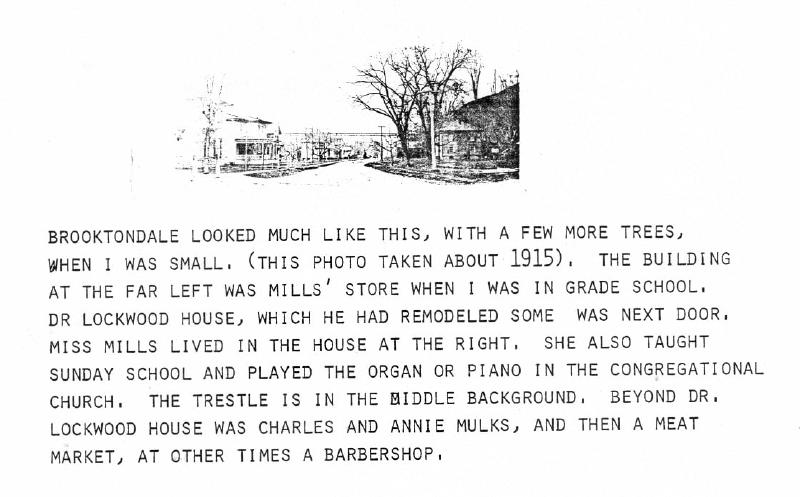
Brooktondale looked much like this, with a few more trees, when I was small. (This photo was taken about 1915). The building at the far left was Mills’ store when I was in grade school. Dr. Lockwood house, which he had remodeled some was next door. Miss Mills lived in the house at the right. She also taught Sunday School and played the organ or piano in the Congregational Church. The trestle is in the middle background. Beyond Dr. Lockwood house was Charles and Annie Mulks, and then a meat market, at other times a barbershop.
— Gertrude Conant. Used with permission. View largest available size.
Emily is not mentioned by name, but is implicitly referenced in a photo caption of a portrait of Jessie Brewer published in 2016, “Around Caroline” by Patricia A. Brhel, p23:
Jesse Brewer ran a dry goods store in Brooktondale, selling fabric, ribbon, greeting cards, and other items. She took over from a woman who had managed a grocery store in the same building and used the proceeds from the store to increase the family income and help support her widowed mother. She was also active in the Caroline Valley Federated (now Community) Church.
M. E. Mills is listed as a “present merchant” in the Ithaca Daily Journal, 26 Aug 1909, p5, in an article “Early History of Brookton Village”.
Notes for Future Researchers
Unfortunately, Emily’s death certificate does little to clarify her birthdate:
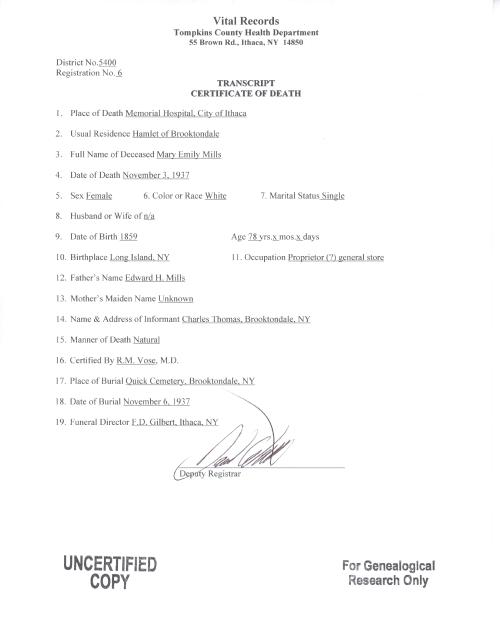
— Tompkins County Health Department. View largest available size.
One of my main goals is to find photos of the family and their stores, but my highest priority is Emily. No known photos of the family exist. I know of only one person still living who interacted with Emily, and that person says their memory would not be good enough to identify Emily in a photo.
In Gertrude Conant’s recollections, she notes that Ellen Gould “looked a great deal like Miss Mills,” so when looking for photos of either woman, one must be cautious not to mis-identify one for the other.
There is an intriguing photo in “Around Caroline” by Patricia A. Brhel that shows a woman minding a general store, with no indication which general store in Caroline it is:

— 2016, Around Caroline by Patricia A. Brhel, Arcadia Publishing, p85. View largest available size.
In the Caroline History Room in Slaterville Springs NY, a version of this photograph exists as a slide, with the words “CAROLINE DEPOT” written on the back of the slide, identifying the store. A mirror image of those words is visible in the following, in the area of the large window above the door:
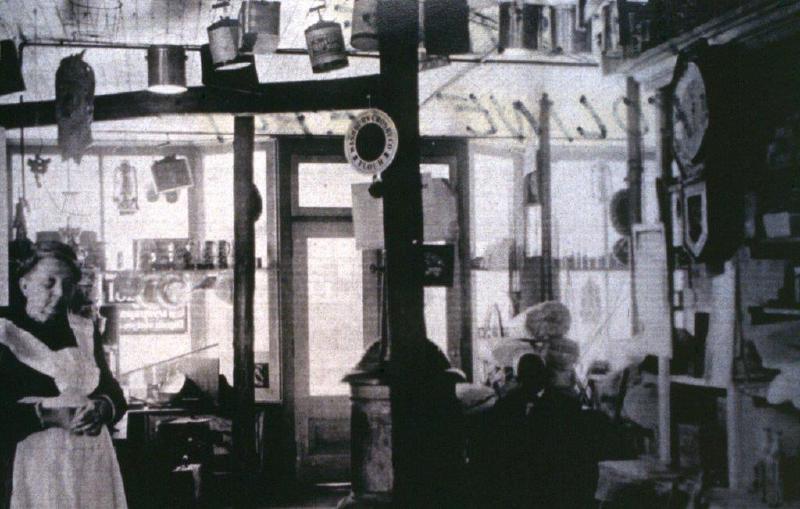
— Caroline History Room, Slaterville Spring NY. View largest available size.
I believe that the reference to “Bertha Mills” in the 1914 American Agriculturist Farm Directory shown below is in fact a misprinted reference to Emily. I have yet found no evidence of a Bertha Mills in Brookton at that time, and everything but the reference to the road on the map in that volume fits Emily. As for the map reference, consider that the same road reference is given for Dr. Lockwood and Frank Mulks, Emily’s neighbors on what is now Brooktondale Road, and who are listed on the same page:
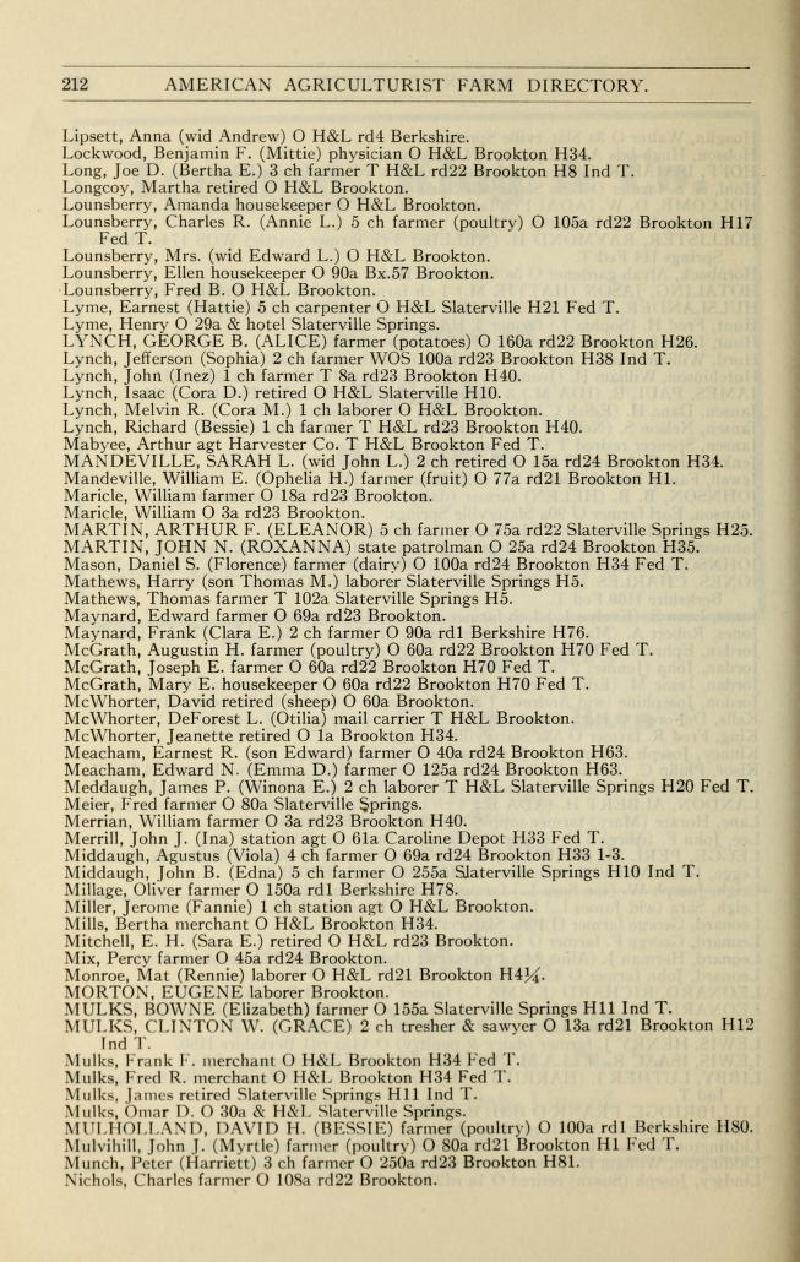
— American Agriculturist Farm Directory of Yates, Schuyler, Tompkins and Seneca Counties New York 1914. Orange Judd Company. p212. View largest available size.

— American Agriculturist Farm Directory of Yates, Schuyler, Tompkins and Seneca Counties New York 1914. Orange Judd Company. p449. View largest available size.
So far I have found only the following with the name Bertha in Caroline alive in 1914:
- Bertha K. Caveney (1886 yo 1960), approximately 28 in 1914.
- Bertha (Pritz) Ross (1876 to 1964), approximately 38 in 1914.
- Bertha (Bogardus) Beard (1873 to 11 Aug 1944), approximately 41 in 1914.
And Emily is the only Mills in Caroline at that time that I am aware.